I was lucky enough this week to be joined by good friend and fellow paddler Chris Charlton, along with a group of first year degree students from UCLAN (University of Central Lancashire) who were studying a mixture Outdoor Leadership and Adventure Sports Leadership. We were based out of Ty’n Dwr Hall in Llangollen North Wales.
We had spent some time discussing our aims and had decided that a journey on Bala Lake was going to be the order of the day. It was a cold and frosty morning as we loaded the boats and sorted the kit, and this cold theme was to continue throughout the day. After a short drive through a wintry landscape, we arrived in Bala and made a quick stop for the all essential brew kit, chocolate biscuits and marshmallows to accompany our Kelly Kettle. Chris and I had introduced the group to and given them a few top tips and handy hints on how to light it the day before whilst paddling at Ellsemere.
Bala Lake or LLyn Tegid (Lake of Serenity) as its know in Welsh, is Wales’s largest natural lake and measures 4 miles (6km) long by a 1 mile (1.5km) Wide. It is crossed by the River Dee and its waters are famously deep and clear. Bala itself is located within Gwynedd in the Snowdonia National Park, partway between Llangollen and Betws y Coed and is easily accessed via the A5 which runs through North Wales.

It was going to be a chilly one!
As we arrived at our launch point I noticed the in car thermometer reading a cool -9 outside! Today was going to be a tad chilly. We had chosen to launch a short distance from the normal shoreline due to the ice on the ramp down to the water. Instead we had opted for a layby approximately 200m further down the road on the Western side of the lake. This proved easier access with only a short boat carry down some steps to the water’s edge. There is a launching and parking fee payable for using the lake, so its a good idea to visit the Lake Wardens Office at the Bala end of the Lake, above the public conveniences prior to launching. You can then be advised on where to launch, weather and any events etc that may be happening. There is also a Watersports Centre (Bala Watersports) based on the lake with hire facilities.
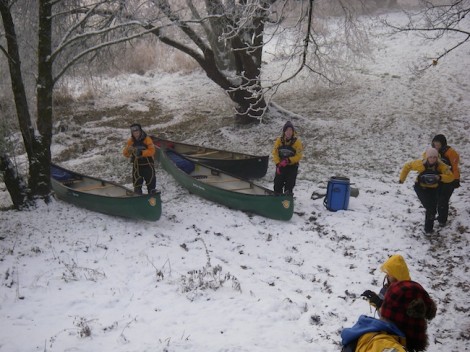
getting the boats to the water
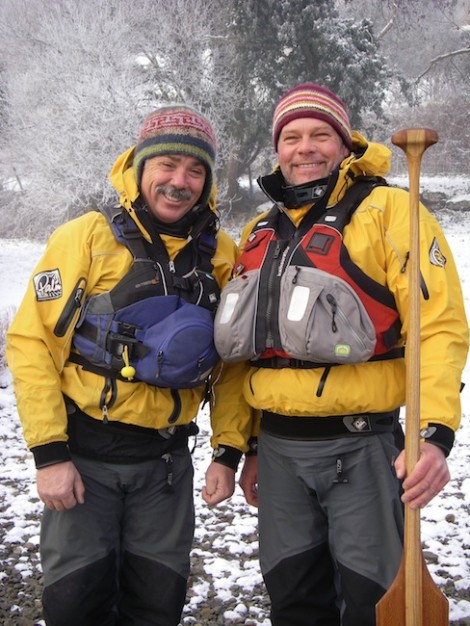
The Chuckle Brothers - me & Chris
As Chris and I got down to the waters edge, the view was stunning and reminded me of the sort of thing you might expect to find on a Christmas card, very white and crisp. There was a mist hanging around over the water producing a very picturesque scene, with every now and then a quick glimpse of the sun. The students even commented on its resemblance of a scene out of Narnia. I have only experienced theses near perfect conditions once before on Bala Lake and it really is hard to try to describe them. I guess you would just have to have been there!
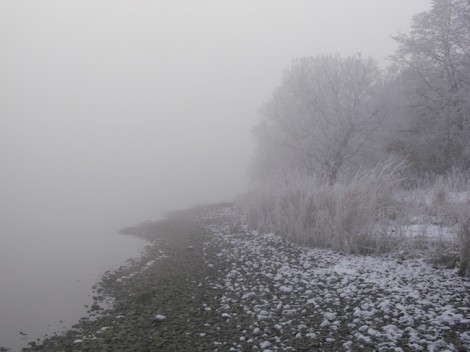

Jules, do I really have to go paddling? Its cold!
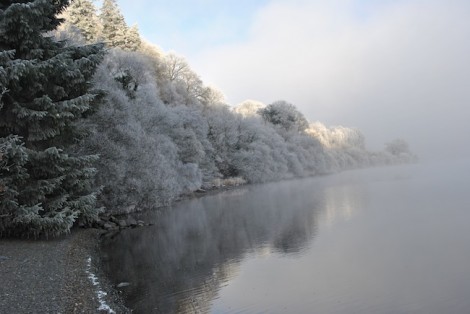
One of the many glimpses of the sun
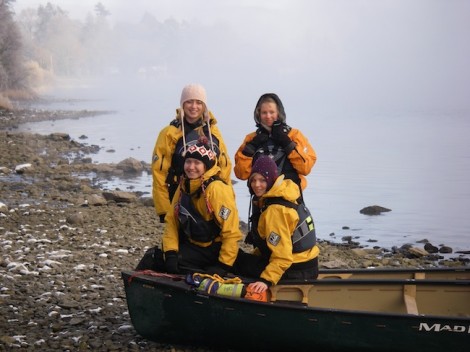
Smiling faces and ready for a paddling adventure
Boats loaded, group briefed we set off into the mist and headed south down the lake keeping the western shore to our right even though we couldn’t see it! It really was cold as we paddled into the magical silence except for the occasional splash from our paddles.
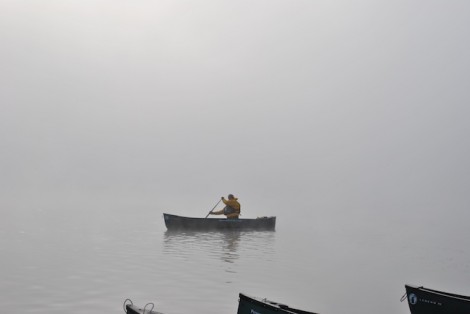
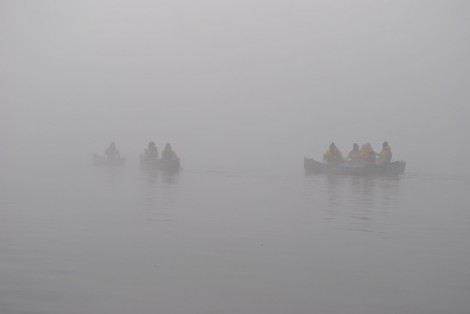

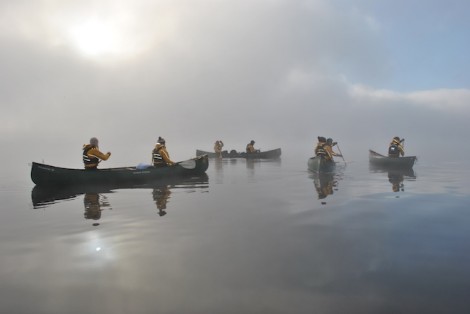
As we paddled along there were more frequent breaks in the mist and glimpses of the sun all adding to the ambiance. During one of these breaks we caught a glimpse of a small cottage on the shore. This seemed like an ideal place for a leg stretch, some lunch and a brew courtesy of our Kelly Kettle.
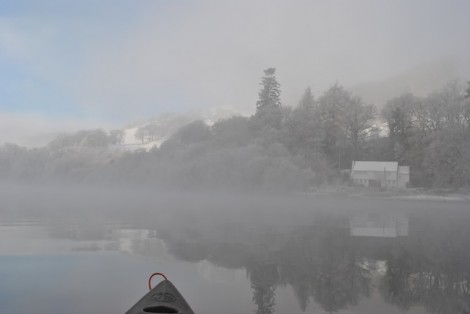
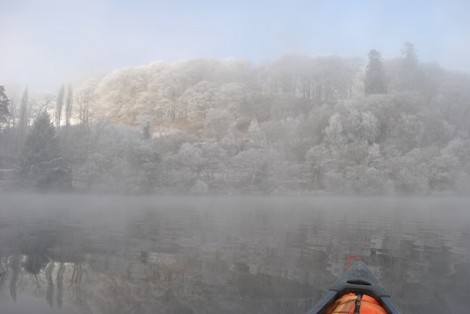
Kelly Kettle’s always seem to go down well with groups. I tend to show people how to light them using Birch bark and a firesteel. My preference for a firesteel over matches or a lighter is that it will still work even when it is wet.
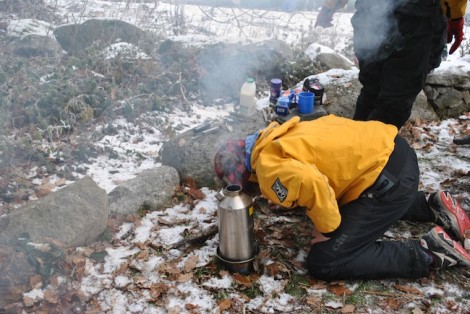

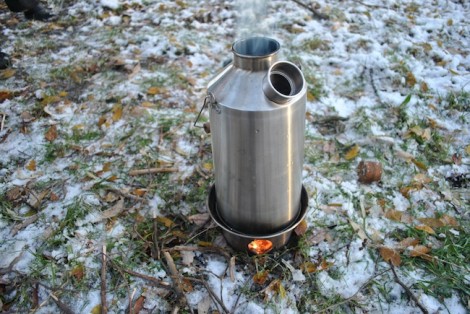
Lunch over with it was time to continue on our journey. So boats were packed, launched and we continued, but first we spent some time revisiting some of the core skills needed for paddling a canoe tandem.



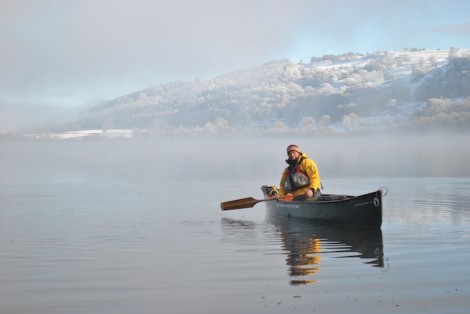
I had chosen my two favorite deep water paddles for the day, both of which were hand made for me by a friend. I am hoping that in the new year he is going to educate me in how to make my own. So Andy if your reading this, big hint!
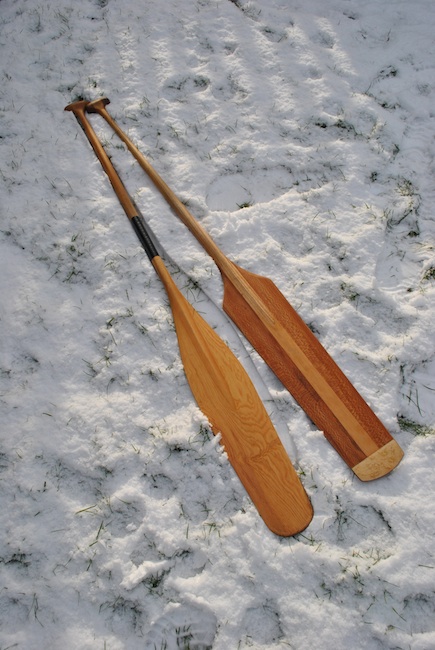
My deep water paddles. Otter tail (L) & Voyageur (R)
Both paddles are well suited to cruising on deep, flat water due to their low aspect. I suppose you could even consider them as your 4th & 5th gear, as opposed to a white water paddle being 1st & 2nd gear. The reason for the Voyageur’s distinct yet simplistic shape is two fold. Firstly it was easy for the Voyageurs to carve with its straight sides when on the trail, and secondly the obvious shoulders makes sure that any water drips run off here, rather than running down the shaft to the paddlers hands.
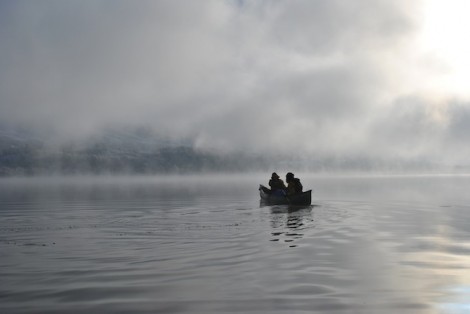
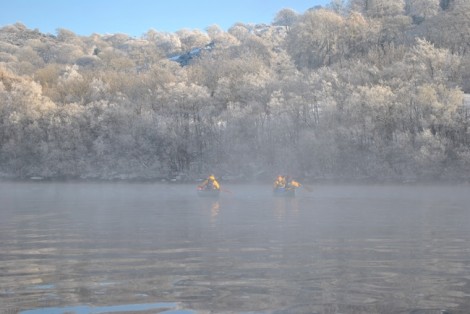
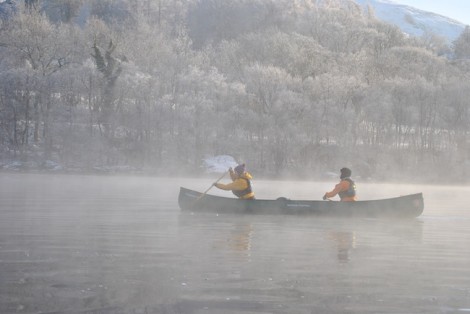
As we paddled once again into the mist the sun and blue sky was now becoming more frequent, and it wasnt long before we reached the eastern shore not far from Llangower Point. From here we headed North up the lake before finally heading back to our start point.
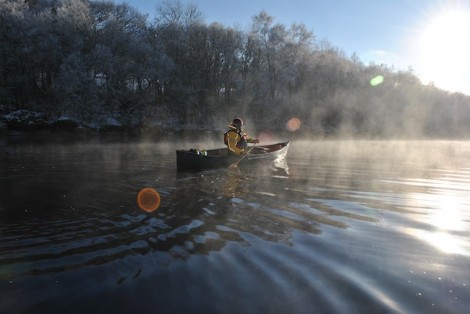
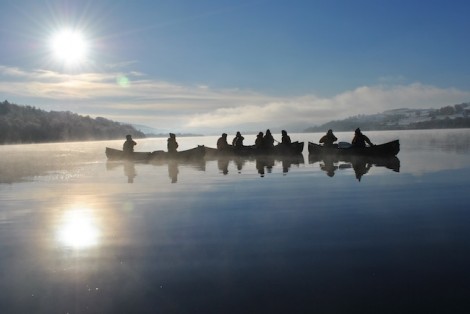



Once back safely on shore it was time for one last brew from the Kelly Kettle and an opportunity to finish off the chocolate biscuits and marshmallows.
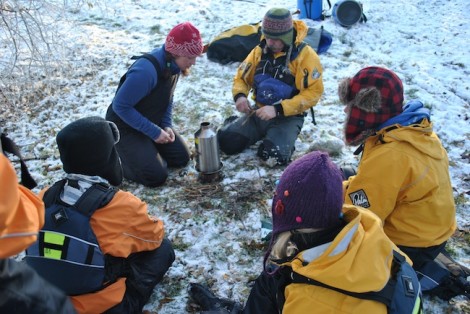
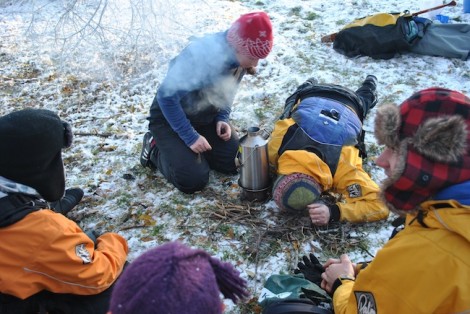
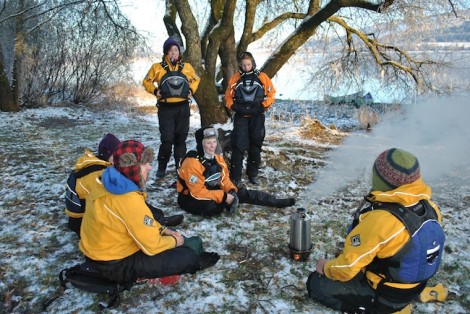
A great ending to a great day, especially in those conditions. I shall leave you with my final view of the day as the sun set.

Looking back over Bala Lake as the sun sets
You can see all the photos from our day on the Voyageur Facebook page here.
See you on the water…
Jules
www.voyageur-coaching.co.uk
Any one that knows me will tell you that Rannoch Moor has to be one of my favorite remote/wilderness spots for a paddling adventures in Scotland. I have completed the cross Scotland trip starting at Kinloch Leven and finishing at Perth a number of times and never tire of it, but I had not completed the trip via the the smaller Lochs Ba and Laidon. So inspired by Justine Curgenven’s recent DVD release, “This is Canoeing” I decided to go and investigate the area in preparation for a future trip.
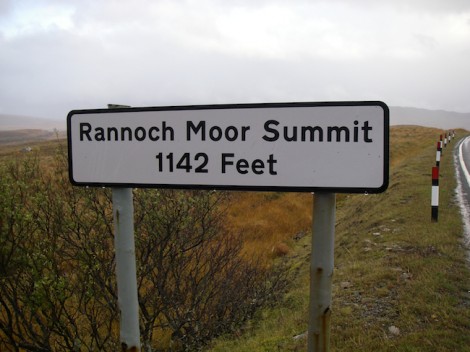
Rannoch Moor - Does what is says on the tin!
Rannoch Moor lies in the Scottish Highlands and can be accessed via the A82 as it winds its way from Glasgow, through Crianlarich onto Glencoe then on to the west coast and Fort William. Due to its height above sea level, its location in relation to the west coast and its weather, expect the climate to be unsettled, often bringing snow, sleet and heavy rain throughout the year. This trip would prove to be no exception!
As I was heading over to Ballachulish for the night and looking forward to the prospect of visiting the Clachaig Inn for a pint of Guinness, I thought I would check out the start point for my planned trip. My start point, Loch Ba is said to be one of Britain’s most remote and windswept points, as the A82 crosses over to Glencoe, and at a height of 1142 ft above sea level. The surrounding area is covered with numerous lochans, streams, peat bogs and mountains that rise on all sides to over 600m and in some cases alot higher.
On arriving at Loch Ba I felt a little deflated as I became aware of some quite serious looking roadworks going on right were I had intended launching! Not to be deterred I headed back from where I had just driven a short distance and in actual fact found a better launch spot with good parking on the opposite side of the road at Lochan Na Achlaise. Winner! The weather was cracking, the views were stunning and I was looking forward to my forthcoming adventure.
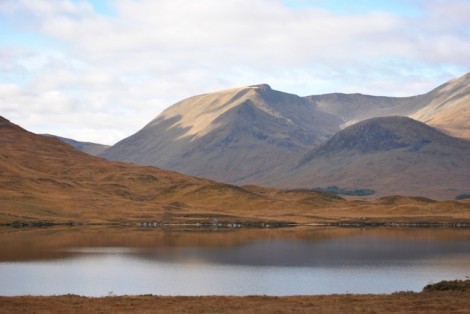
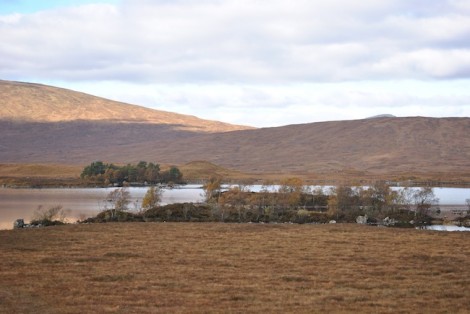
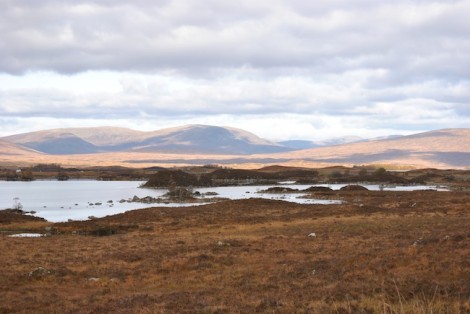
Looking across from my start point Lochan Na Achlaise, on a dry day!
The morning after my recce and visit to the Clachaig Inn dawned a little different to the previous day! It was poring with rain and blowing a gale, and this was at sea level. Not to miss the opportunity I ventured out and drove back up the Glencoe Pass to my start point.
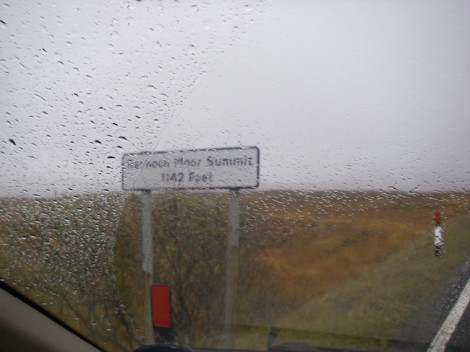
Not quite as I had remembered it form the previous day!
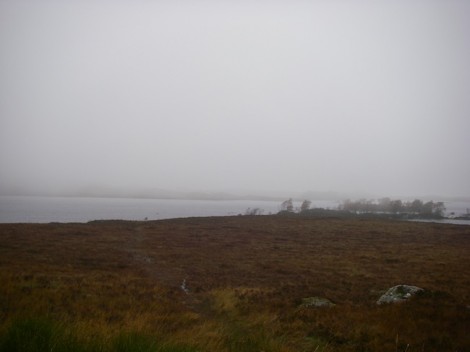
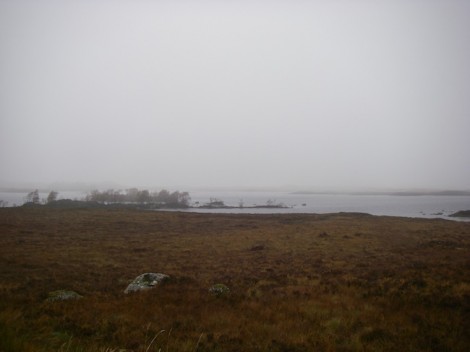
A different look to Rannoch Moor
My plan now was to head out of Loch Na Achalaise via a tributary that fed into Loch Ba. Then to paddle its length and again pick a tributary this time leading into Loch Laidon, then continuing on to Rannoch Station, an over night bivy and reverse the route back to where I had started. Easy!! Or not as the case may be.
As I unloaded my boat and kit in the wind and rain, a figure emerged from a rather steamed up 4×4. This turned out to be a guy visiting from Norway and in some broken English asked me as to my intentions. At this point he looked somewhat shocked, wished me luck and diapered back to the steamy 4×4.
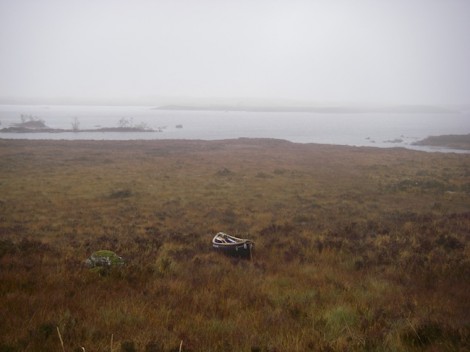
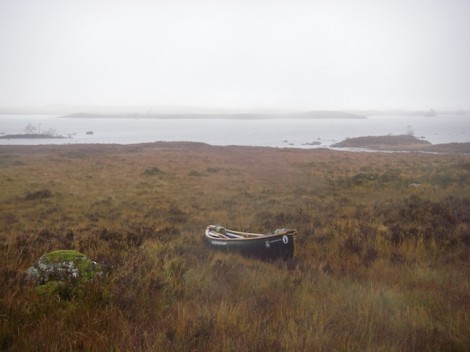
Getting my boat down to the water
As I unloaded and launched my boat etc I became aware of a very strange noise coming from the mist. After having heard it several times it dawned on me as to what it was, a roaring Stag! At this time of year the Stags are in their rutting season and competing for the females (Hind). This roaring is a very distinct if not unnerving sound especially when it is coming out of the mist and you cant actually see whats making it. The Stags roar in order to maintain control over a group of females and to constantly drive away rival males. I was now hoping I might catch a glimpse of one of theses magnificent beasts roaring. Bit difficult in a bright yellow cag though!

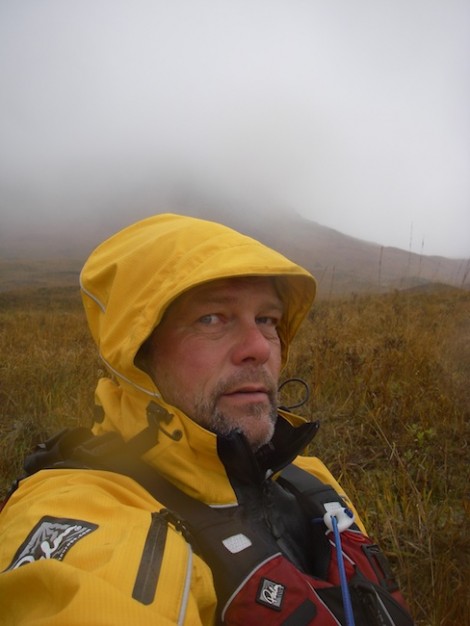
Time for a break whilst keeping an eye out for Stags
The weather was definitely getting worse, and I was beginning to think that maybe I wouldn’t make my goal and more to the point was this such a good idea? After a brief chat with my self I decided to continue and seek shelter under a small bridge over which the A82 ran and have some lunch. This comprised of some brown biscuits and vegetable spread followed by some fruit biscuits and chocolate all left over from a military ration pack I had recently used for some work.
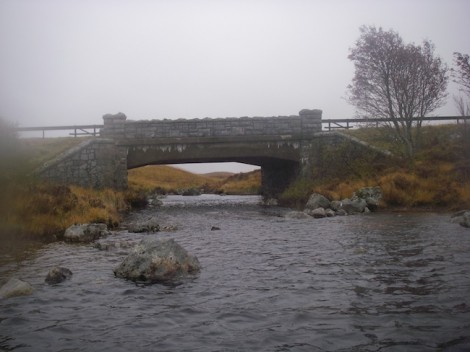
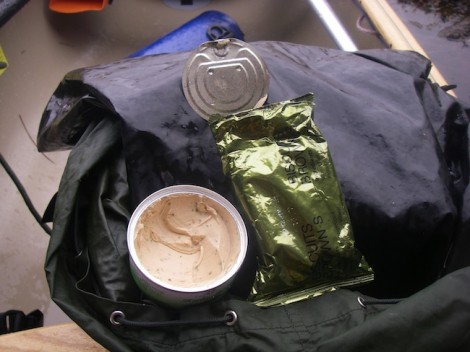
Lunch and a blast from my past
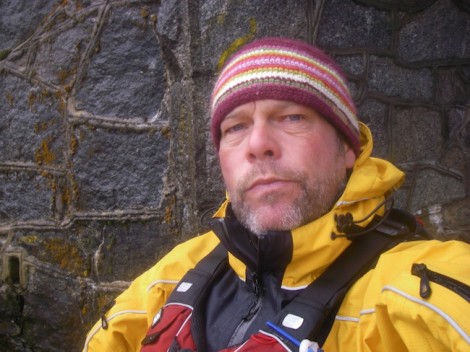
Savoring the exquisite cuisine
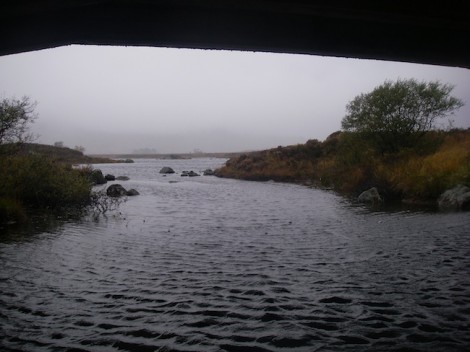
Looking back into Lochan Na Achlaise
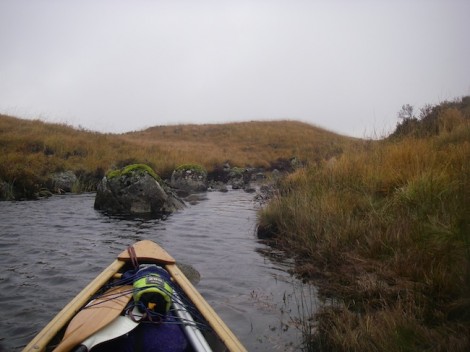
Time to portage
After my brief lunch it was time to move on, however as you can see from the picture my path was blocked largely due to a lack of water. My only option now being some form of portage. The ground was to too soft and boggy for a trolley, plus I’m not really a big fan of them. Carrying my boat on my shoulders with the aid of the Yoke was also not an option due to the soft uneven ground. This left me with the only option. Dragging! So I rigged a quick harness system and used the two half’s of my canoe pole like ski poles and set off looking something like a Polar explorer man-hauling a pulk. It wasn’t really possible to carry kit and drag my boat so I decided to carry my kit a short distance first and whilst doing so I could identify a suitable route to drag my boat along. Once my kit was dumped I could return unloaded and collect my boat. I use a similar routine when carrying my boat and adopt a preference for quite short legs or stages as I go. A stage was a convenient stopping place used by Voyageurs at which loads were dumped, and they were generally around six minutes apart. This being the length of time a man could walk with a good load without fatigue. The idea is that he would recuperate on the way back for the next load. It was taken from the native Indian system of packing allowing better time to be made.
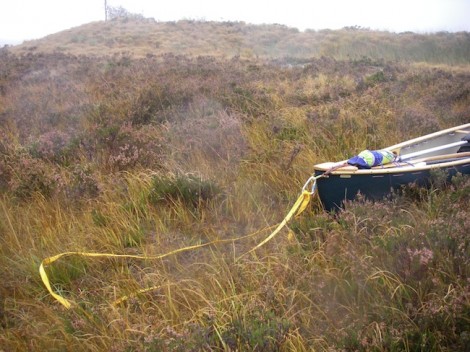
My simple harness

I eventually arrived at the start of Loch Ba and wasted no time continuing on my trip. However as I was about to get into my boat I noticed something moving in the grass. On closer inspection I discovered I had a friend in the form of a small frog!
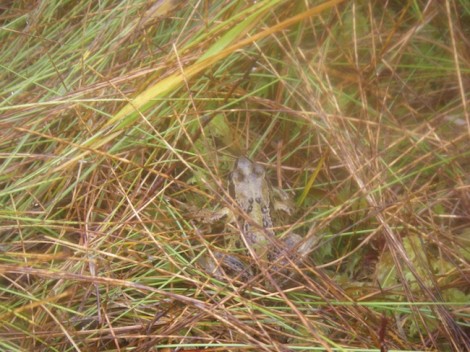
My little friend
Loch Ba is approximately 2.5 long and eventually leads into the River Ba which flows into Loch Laidon. It was around this point that the weather calmed down for a while and I was again aware of that haunting sound of the roaring Stags. I decided that as the noise seemed close I would investigate further and see if I could locate the Stag and possibly get a picture. I set off and sure enough during a brief break in the mist, a large stag in all its glory appeared about 150m in front of me, with another one on top of a rise some distance way. Between them was a group of 5 or 6 females (Hinds). I decided to try my luck and get closer, but as I have already said being in a bright yellow cag probably wasn’t the best idea. As I got closer and with one last roar the closest Stag took flight and disappeared with his hareem. I quickly grabbed the chance of a picture. Its not the best but here it is.
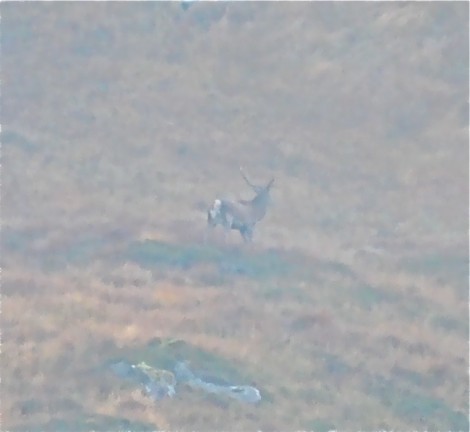
The Roaring Stag
After another couple of km dragging, carrying, poling, lining and paddling I entered Loach Laidon. This now felt very remote and wild and despite the weather the scene was stunning, I had a real sense of pleasure getting here. As if by magic a Royal Navy search and rescue helicopter appeared very low but above me. It was so low infact I could clearly see the pilots face. I guess they were just wondering what or who was up there dragging a canoe around in this weather. The side door slid open and the winch-man appeared signaling to me an OK sign with his thumb. I returned the gesture with both thumbs and with he a big smile on his face he returned in side, closed the door and as quickly as it had appeared it disappeared. A quite surreal experience!!
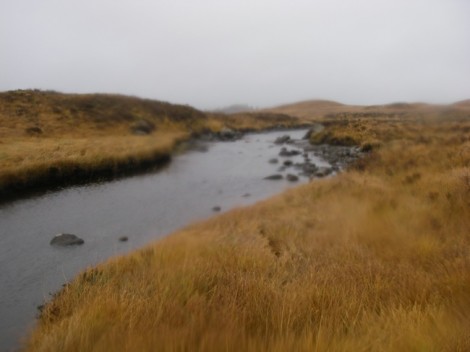


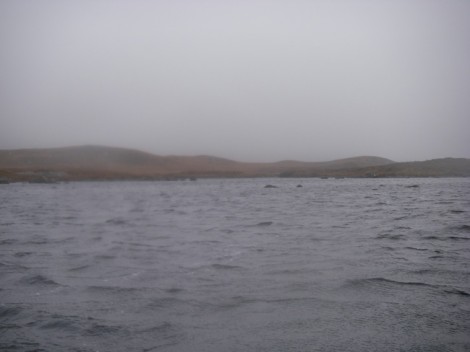
Unfortunately at this point my camera gave up the will to live! So no more pictures. I was now quite aware of time and the weather, as I had pretty much had the wind behind me all day aiding my progress. I was now just over half way down Loch Laidon and the weather was definitely worsening. If I cut my journey short now and started heading back I would probably make it back to the car that night. If I pushed on to the end of the Loch I couldn’t guarantee finding a suitable bivy spot, and if the weather deteriorated yet further over night then I couldn’t be sure I would get back.
Decision made I turned around and headed back. Batting into the wind was no pleasure I can promise you. By the time I reached the car the light was fading and I was tired but happy.
I now had a good idea of what would be involved when I attempt a crossing from here later next year. Another thought is to start down near Oban, up Loch Etive and then portage Glen Etive via road and tracks to reach Loch Ba and then continue the crossing via Loch’s Rannoch and Tummel etc. Either way it will make for an interesting tale.
Rannoch Moor really is a special place and I would encourage you to go and paddle it for your self. Remember though it is a serious trip and a remote environment so make sure you are well prepared for the weather you may encounter and carry the right safety kit.
Meanwhile I’m busy planning a winter trip starting at Mallaig journeying to Loch Arkaig and on to Fort William or even Ballachulish.
See you on the water….
Jules
www.voyageur-coaching.co.uk
Last week I joined a couple of old friends Ken and Cilve for a trip from Glasbury to Hay on the River Wye in South Wales
The River Wye (Afon Gwy) is the fifth longest river in the UK and for parts of its length forms the border between England and Wales. Its source is in the Welsh mountains near Plynlimon and it is around 215 km in length. It flows through or near several towns and villages in South Wales including Rhayader, Builth Wells, Hay-on-Wye, Hereford, Ross-on-Wye, Symonds Yat and Monmouth finally meeting the Severn estuary just below Chepstow. Due to its slow flow it is a popular venue for canoeing especially for introducing beginners (grade 1-2), and hence the large number of local centers that use it. There also numerous company’s offering the hire of boats.
The area of Symonds Yat offers some more challenging paddling and the sections above Glasbury offer some good grade 3-4 rapids in the right conditions. This particular section from Glasbury to Hay is around 10 km in length and could be done in a couple of hours.
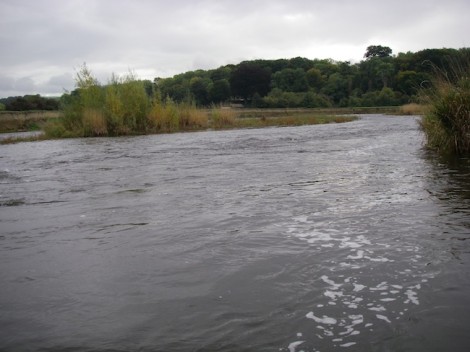
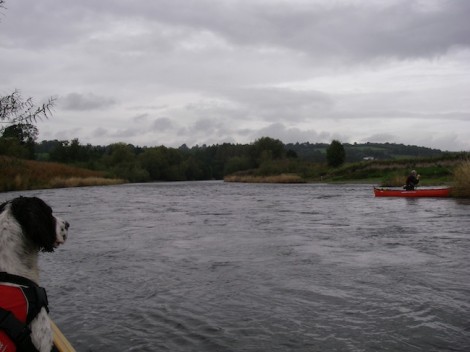
Tranquil surroundings near the start
I was also accompanied on the day by trusted hound Rannoch. He is a five year old Springer Spaniel who just loves it in the canoe. He is real muck magnet, trust me when I say I could take him to the desert and he would find both mud and water! Inevitably the inside of my boat always ends up wet and very dirty. He doesn’t always get the chance to come on trips with me, but today was different. He is generally quite good in the boat and can be very useful addition for adjusting the trim when needed.
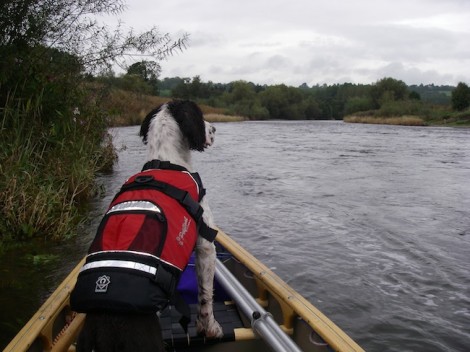
The rivers winds its way through the country side at a leisurely pace with the Black Mountains as a majestic back drop.
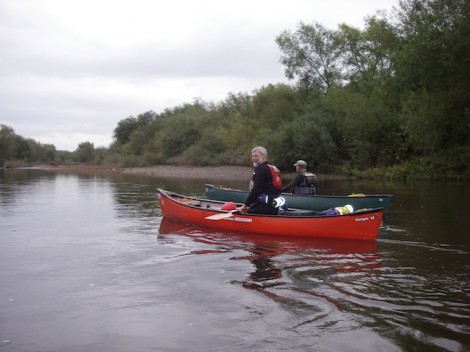
Ken and Clive
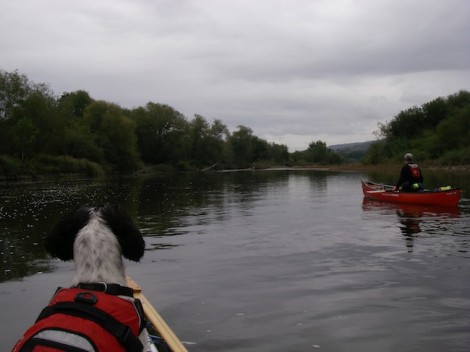
Rannoch keeping a watchful eye on the proceedings
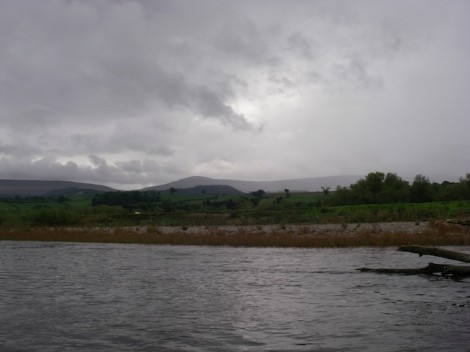
The Black Mountains in the distance
Despite the slow and tranquil flow of the river, some care should be taken as there are numerous dead and living trees in the river, forming quite large strainers. Carrying a folding saw is always a good idea.
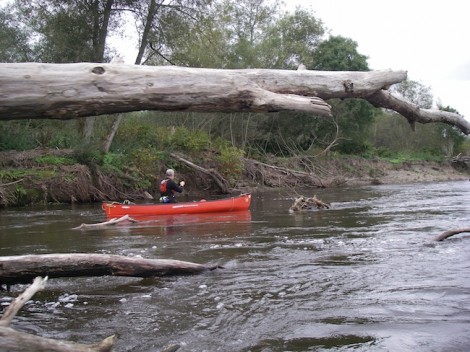
Ken and one of the many dead trees in the river
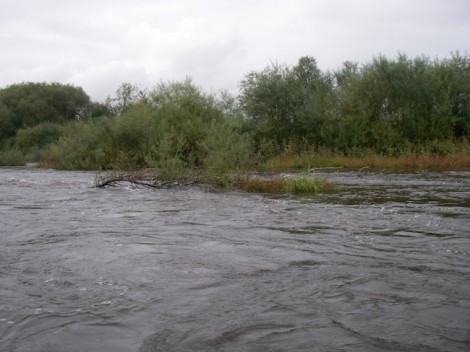
Th river has changed shape quite dramatically since I last paddled it a few years ago, with one large sweeping bend near the start now being replaced by a straight section. There are numerous opportunities to leave the main river and explore some the tributaries that join it. Good time to get the poles out me thinks!
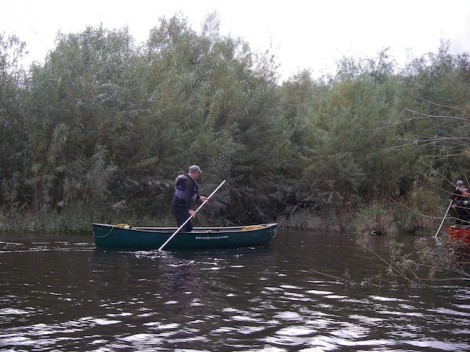
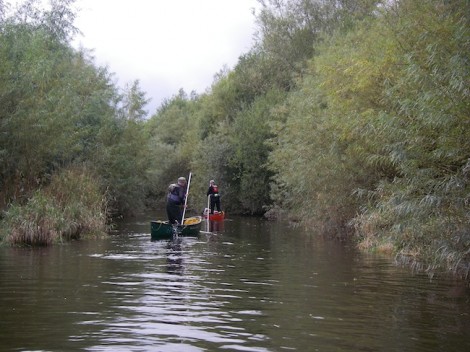
Ken and Clive off exploring
After a short stop for lunch we continued on our way. The weather had by now really improved and the sun was warming us nicely.
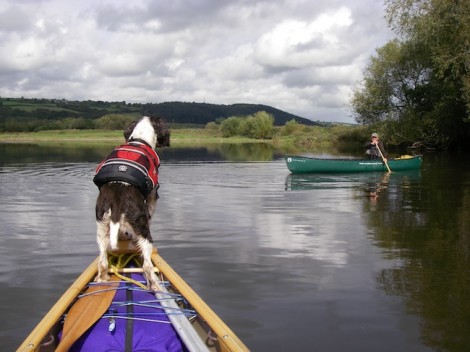
Rannoch offering Clive some coaching
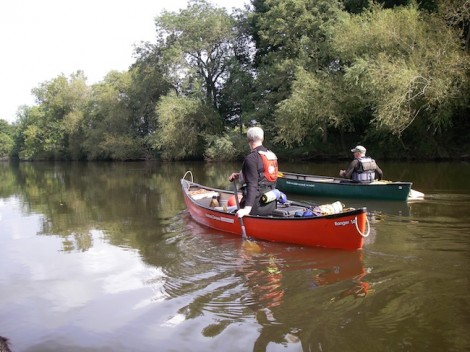
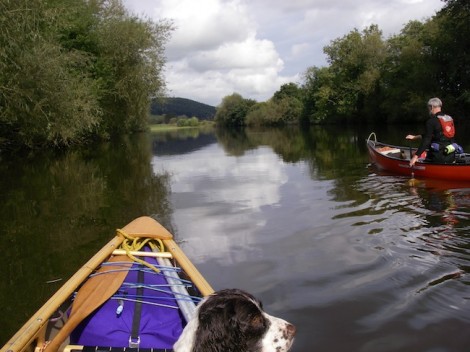

Rannoch catching some rays
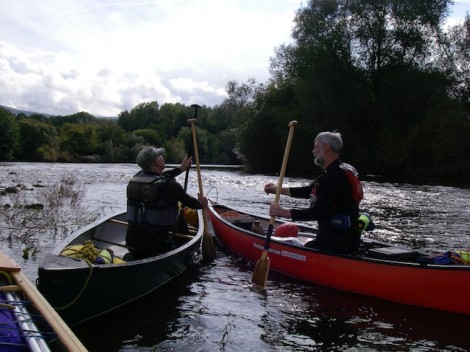
No, no mine is definitely bigger!
As we rounded a corner that led to a long straight the sun disappeared and it started to rain. In fact it started to pour down, so much so the rain was bouncing back up!
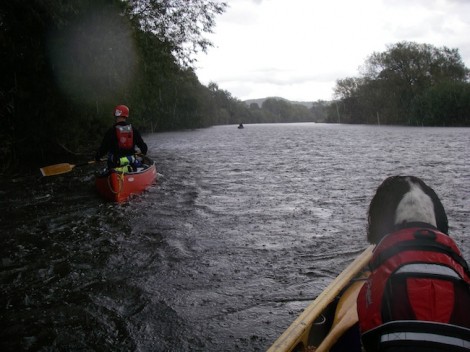
And so the rain started
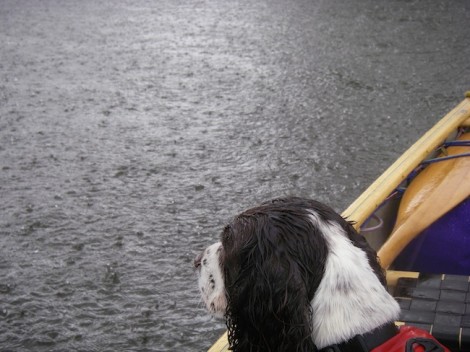
A very un-impressed Rannoch
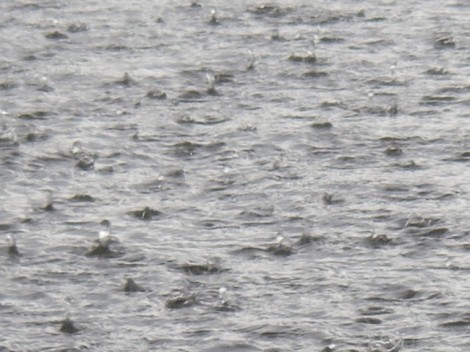
Bouncing rain!
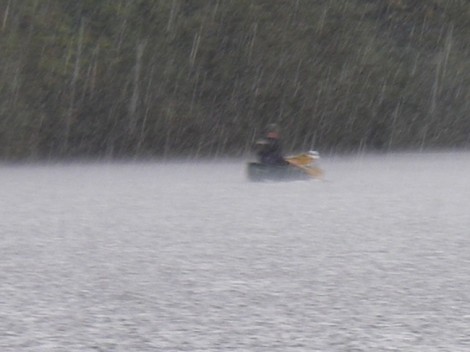
And then it rained some more
Then almost as quickly as it started, it stopped. We continued on our way past an old broken weir and on to the get out.
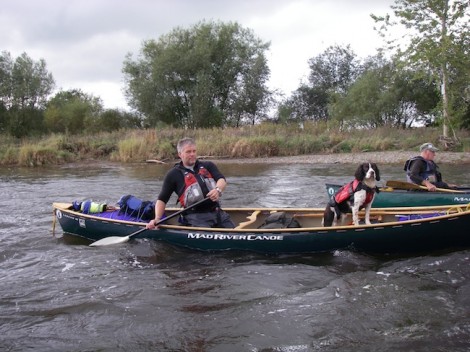
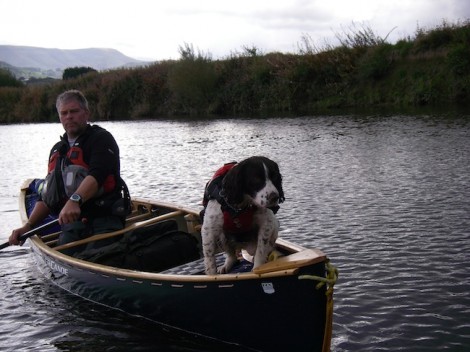
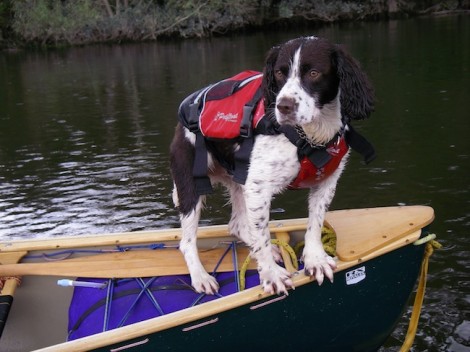
Rannoch on Iceberg watch
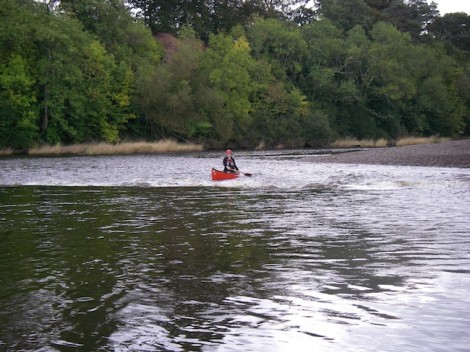
Approaching the old broken weir
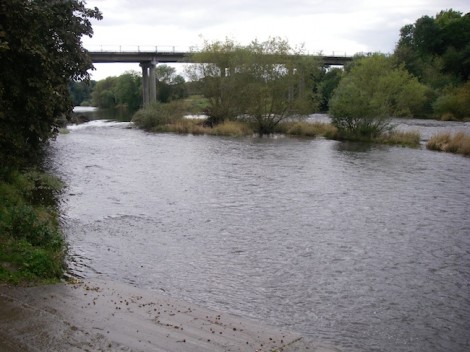
Looking back up the river from the get out
The get out is directly after the bridge in Hay on river right. This can be quite busy with other users, especially groups.
I’m not sure if I have really done this trip a justice? It really is a great day out whether you’re looking for a relaxing days paddle or as a venue for introducing people to open canoe. The trip can be extended as much as you like or done as a multi day trip all the way to Chepstow. Wild camping is not really option but there are a number of campsites along the way, and pubs offering fine ales and good food. So if you haven’t done it yet, add it to your to do list.
I had a grand day out and so did Rannoch. Thanks to Ken and Clive for their company.
See you on the water…
Jules
www.voyageur-coaching.co.uk
I recently had the pleasure of paddling from Glyndyffrdy to the Horseshoe Falls on the River Dee in North Wales. I was there to assess a number of candidates for the British Canoe Union (BCU) four star leader award in canoe. This award allows individuals to lead a group in moderate water conditions. Moderate water is defined as: large areas of open water (lakes,lochs) with winds up to force 4, and grade 2 rivers.
The River Dee or Afon Dyfrdwy as it is known in Welsh, starts in the hills south west of Bala and then flows for about 10 km before entering Bala Lake (Llyn Tegid). The canoeing sections start from below the lake and work their way through the country side to Llangollen. After this the river continues its path cross country, leaving Wales and entering England shortly before Chester, where it then flows flows into the sea. Access can be a problem on some sections, however this section is regularly paddled and parking is courtesy of a local farmer who charges a small fee for the pleasure.
As a an indication to the level on the day you can check the gauge at Mile End Mill. On this day it was on 11 proving good conditions of continuous grade 2.
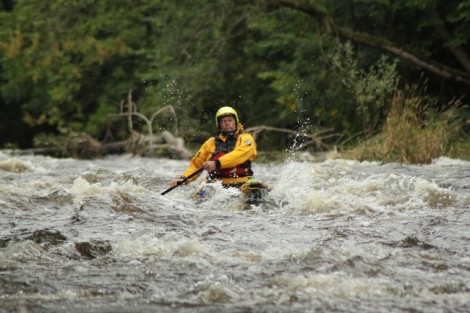
Good conditions for this section
I was joined on the day by my friend and fellow coach Chris

My partner in crime Chris
This really is a lovely section of river at the grade. Large sections of grade 2 rapids, with waves to be surfed interspersed with short flat sections. Add to this the stunning scenery with the hills as a back drop. Around half way down a nice surf wave can usually be found, however at this level today it was washed out.
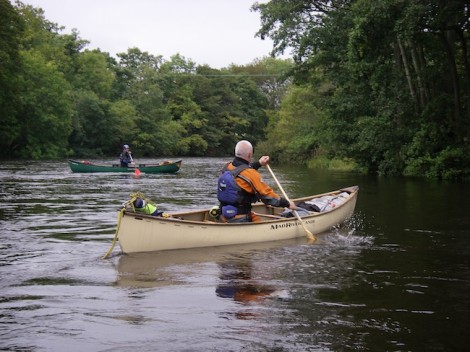
Flat section close to the get on
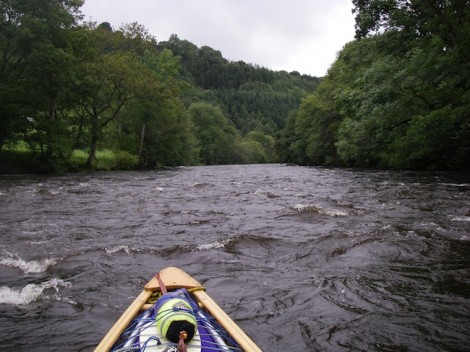
Approaching some rapids
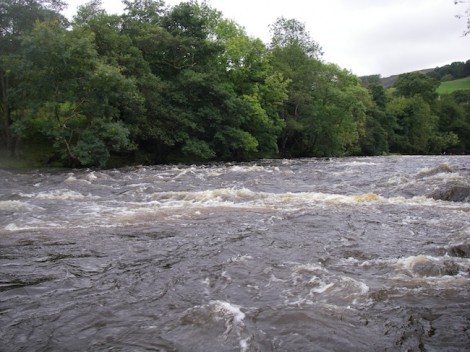
Looking back up one of the rapids

One of the group conentrating hard
Unlike paddling a kayak open boaters have a real chance of swamping. This can be good fun if just messing about or on a short paddle, but if the boat was fully laden as for a multi day trip then it could become an issue. A useful strategy when running sections like this in open boat is to try and slow your self down, or check your speed in order to avoid swamping. Combine this with use of the reverse ferry and a clean or even dry line can be achieved. An alternative to this is, where you find a downstream ‘V’ or tongue is to adopt a style similar to the Voyageurs, who ran a line slightly to one side of the apex of the ‘V’ resulting in a drier descent. The line was know as a ‘filet d’eau’ or fillet of water.
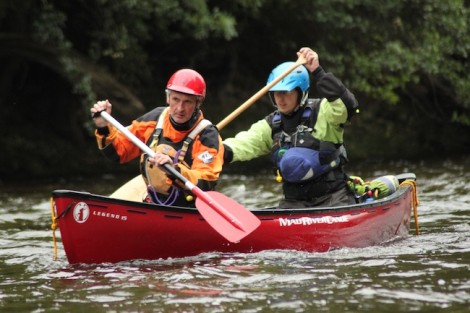
Iain and David joined us for the day
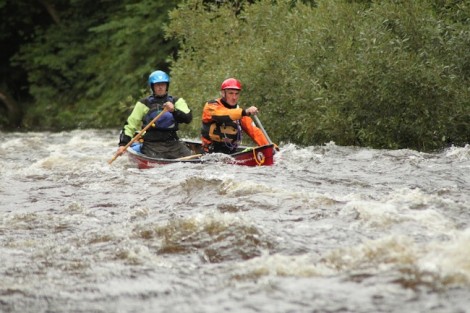

I t was nice to see that a tandem crew joined us for the day, which gave he candidates on assessment a bit more to think about.
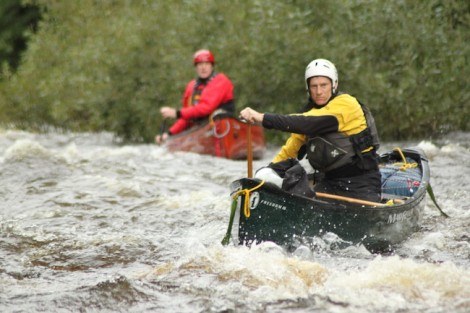
Andy one minute a paddlemaker, next a paddler!
As it was a leadership award Chris took it upon himself to discuss the different leadership styles with the group and introduced them to the lesser known style AMFYOYO!! This is only to be used in times when all else has failed, and stands for “Adios my friend your on your own!” I think we can all think of a situation when this was probably quite apt.
Leadership need not be difficult in this environment if a logical approach is taken to it. Ask your self a few simple questions:
Where do I want to go or be?
Can I see where I want to go or be? If not move somewhere you can
What hazards if any are between me and my destination, and how big a hazard do they pose?
Can the hazard/s be avoided or what can I do to lessen the result?
How many boats or swimmers can I deal with here at one time?
What style should I use? One at a time, eddy hop, leap frog etc
Remember if all else fails.. AMFYOYO, But don’t. quote me on that
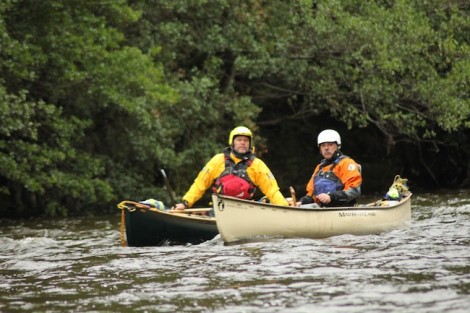
Chris and I discussing the merits of AMFYOYO!
The day moved on and lots more fun was to had on the various sections of grade 2. A brief stop for lunch was followed by some nice rapids. Thank you to Simon (aka Redframe) for the following shots of myself doing what I enjoy.

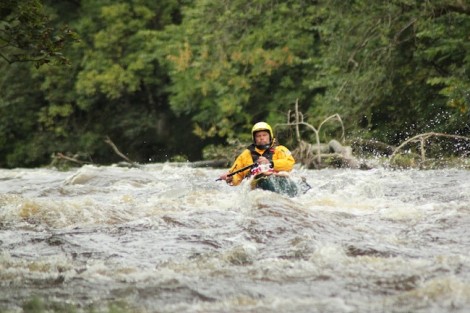
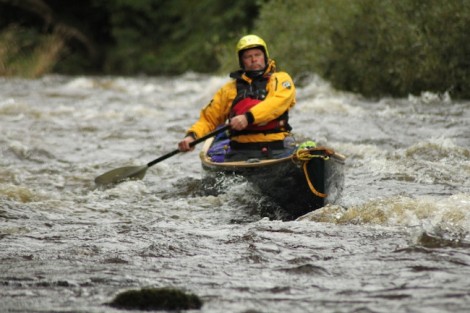
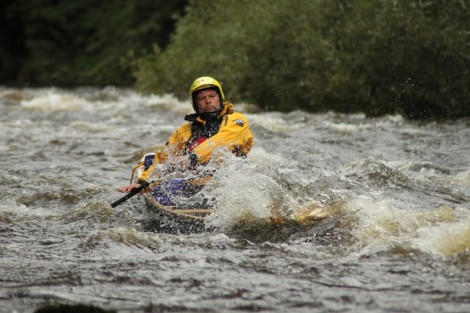

There was then one last rapid that led to a slow flat section which gave us warning of the approaching Horse Shoe Falls. Great care should be taken on approaching the falls especially at this level as a powerful recirculation is formed below the weir. Egress early on river left and portage round, or if care is taken in lower conditions and keeping well clear of the weir there is the option of a sneak down the side.

In case you wondered, no this is not me! Its Sue strutting her stuff
This was all the fun over with for now. All that was left to do was to paddle down the canal to the Eisteddfod International Pavilion (small parking fee) where we had left the vehicles. Alternatively the river could be paddled further taking in the section of the Serpents Tale (grade 3 -4) and continuing down grade 2 rapids to the white water center at Mile End Mill.
The section described here from Glyndyffrdy to the Horseshoe Falls is approximately 10 km (6 miles) in length and is a really good day out.
A big thank you to all of that gave your time and joined me for the day.

The motley crew
See you on the water…
Jules
www.voyageur-coaching.co.uk
Day two started much as day one had ended, cloudy and overcast with a stiffening wind. I was awake at first light as usual and used this time to plan the day.
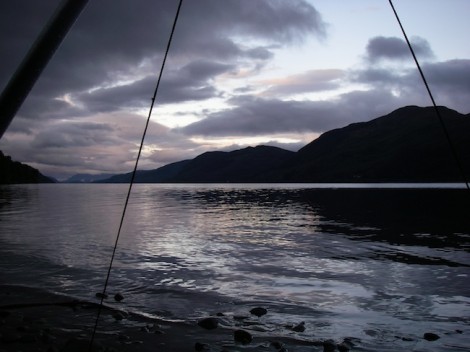
A dawn view from my tarp
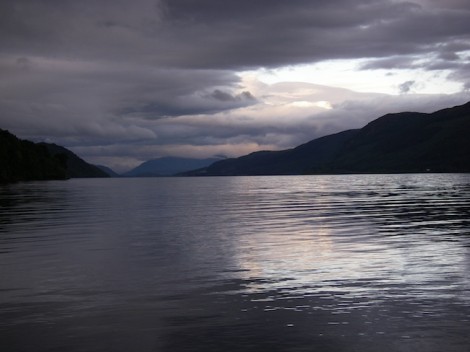
Looking south from where we had come from
On waking I was quite surprised to notice the that the water that was some two feet plus away from my tarp the previous night, was now considerably closer. In fact I could actually lean out of my tarp and fill my mug from the loch. It had rained the day before admittedly, but with the loch the size it is I was surprised to see how much it had risen overnight. A good learning point for the future me thinks!
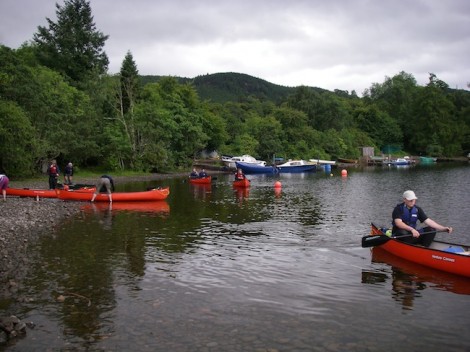
Leaving Foyers on day 2
Breakfast done and kit packed we set off hoping to make it to the end of the Loch on time, as planned for our pick up.
When tackling a multi day journey like this, some thought should be given as to how you carry your kit and load it into your canoe. As most of my journeying is solo I tend to adopt a three line system. First line is what I carry on my person or in my buoyancy aid, a bit like a small survival kit just in case I become separated from my boat and my main kit. This tends to be a good knife, a folding saw and a fire steel for lighting fire along with a bit of food (nibbles), simple first aid (electrical tape) and a light source.
Second line is a waterproofed day sack with all the stuff I may need during the day. This includes a warm top, hat, sail, food, drink,a comprehensive first aid kit and any thing else that may be needed to deal with the days events.
My third line is my main sack, containing all my important warm dry stuff like sleeping bag, spare clothes etc. Once this is packed and sealed at the start of day, it doesn’t get opened again until I make camp. This way there is little chance of things getting wet or lost.
As I was on open water I opted to lash my kit into the boat instead of leashes as once my boat was trimmed for the day little adjustment should be needed. Not only that but should the boat become swamped the lashed in kit can add buoyancy to a swamped boat.

Back on the western shoreline

The group had asked that we cross back over to the Western shoreline in order that they could have a better look at Urquhart Castle. Though now extensively ruined, the castle was in its day one of the largest strongholds of medieval Scotland. It is also near here that the majority of the sightings of Nessie occur!
So the plan now was to head further up the Eastern shore to Inverfarigaig before crossing back over to the castle. The wind was now quite fresh, and as we set off across it became apparent that one of the tandem crews was having directional issues. My only option was to take their painter and tow them the 1.5 km or so to the other side. Trim is really important when paddling canoe, especially in windy conditions. It can make the difference between a good day or a bad one.
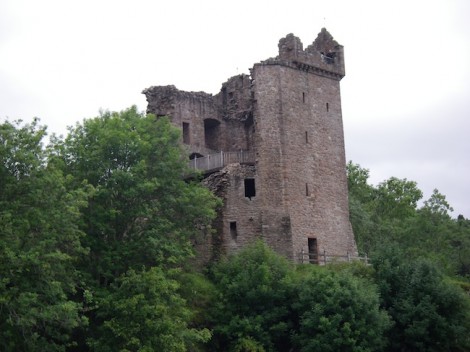
Urquhart Castle
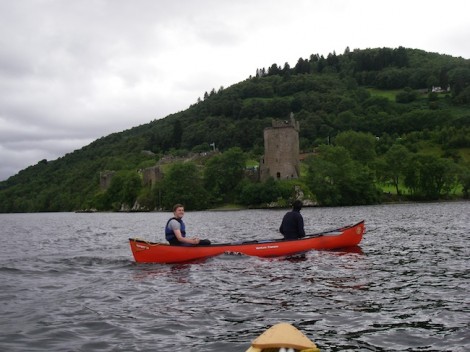
After a short stop for lunch we continued on our way. Whilst crossing Urquhart Bay a strong gust of wind came in from our left. This very quickly carried one of the boats plus the boat it was towing over 1 km out into the loch. Beware of strong of wind gusts funneled in by the shape of the valleys and surrounding land mass.
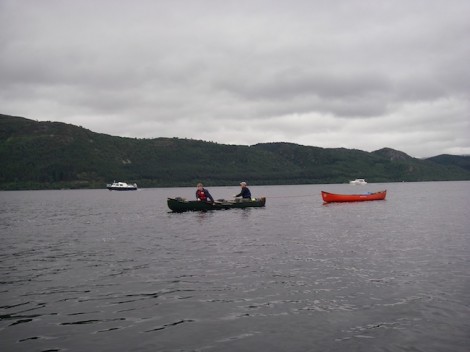
The boat that was blown away
Once re-grouped we continued on our way. The plan now was to get a pick up from Dores, just short of the end and back on the eastern side. It’s a long story as to the reason why we would have to cross the loch again!
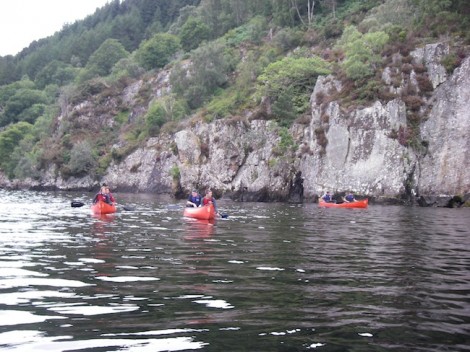
A sheltered and more relaxed paddle
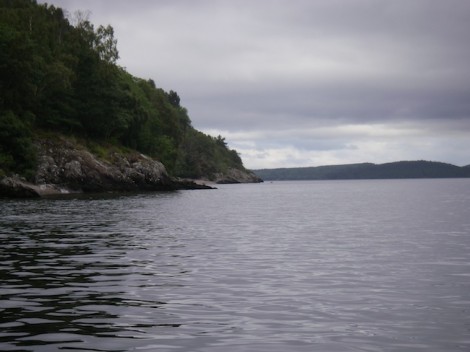
The end in sight and Dores over to the right
The wind again picked up, and as had always been the case so far not going in our direction. As we neared Dores this wind had become quite fresh, so we made the most of any shelter created by the shore and stayed close in. The prospect of another crossing didn’t particularly excite me, especially after having had to tow a boat in the morning and the fact that people were now starting to feel a bit fatigued. Add to this the fact the crossing would be around 2 km or more, so we made a quick stop for a brew and I concocted a new plan. I made a quick call to our pick up and instead arranged them to meet us on the beach at Lochend.
Despite the fact that it appeared we were paddling into wind the clouds behind were getting darker and thicker. In fact it almost appeared what was behind us may be catching us up!

The clouds fast catching us up
As is quite often the case when you have spent all day paddling into the wind, it suddenly changed direction and gave a slight helping hand for the last km or so. As the beach in the distance grew closer there was a certain air of success amongst the group . Only two days previously it had been a real challenge for them to paddle a few hundred metres with any hint of real control and for some it had been their first time ever in an open canoe. Now they had some 23 miles of water behind them and they really could say that they had paddled from end to end on Loch Ness.
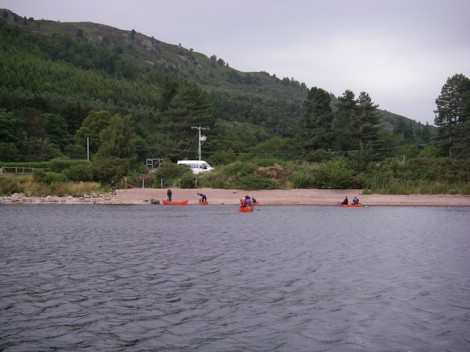
Our finish point, the beach at Lochend
I would recommend this trip to anyone who enjoys touring/journeying in open canoe. It can either be done as the trip described or as a part of the Caledonian Canal if looking for a longer trip l. There are lots of opportunities for wild camping, but I would recommend keeping this to the eastern side of the loch, as the A82 runs very close along the western shore potentially making for a noisy camp. The weather can really play a big part in this trip, and effect the outcomes. As mentioned the waves or swell can be quite big with the potential for swamping the boat. Make sure you check the forecast in advance and if in any doubt wait for better weather.
Well done to the group and I hope that during the week I manged to inspire and enthuse you enough about open canoeing that you will, if you haven’t already done so go and have your own canoe adventures.
See you on the water…
Jules
www.voyageur-coaching.co.uk
I was recently asked to spend a week introducing a group of people to Open Canoeing in the Scotland. After having spent only a day and a half getting to grips with the basics as a tandem crew, I decided that it was time to venture a little further and attempt a two day journey with an over night camp. What better way to learn about the subject than by simply going and doing it? After a brief chat with my group whilst traveling back from a day on Loch Ussie, a unanimous decision was reached. The journey/camp was to be on the classic Loch Ness.
Loch Ness is a very large, and very deep fresh water loch in the Scottish Highlands, and is part of a cross Scotland route know as the Caledonian Cannal which in its self is part of the Great Glen. It lies South of Inverness and is some 23 miles (37km) in length. Despite its size it is the second largest Scottish loch by surface area after Loch Lommond . It is probably best know for the alleged sightings of the legendary Loch Ness Monster, otherwise know as ‘Nessie’.
I feel the open canoe can really come into its own when introducing people to paddlesport. It is a great way to encourage teamwork, communication and trust especially when tandem crews are used. Not only that but it really doesn’t take that long to give people the basics to get going and then head off on some journeys.
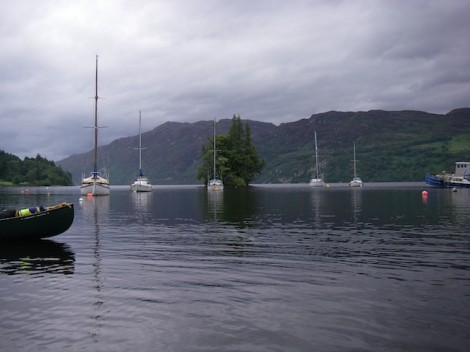
Looking out from our start point towards Cherry Island
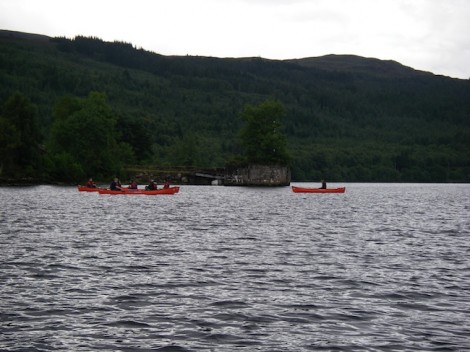
Passing the old pier
Our drop off point was not far outside Fort August on a midge infested slipway looking out to Cherry Island, which is the only Island on Loch Ness. Although all that can be seen today is a rocky tree clad island, it is in fact man made and known as a crannog.
Midges don’t normally bother me too much but these were really bugging me! So we quickly unloaded the boats and kit and had a chat about our options. The decision was made that in order to claim we had truly paddled from end to end, we would firstly have to head back towards Fort Augustus to where the River Oich entered the loch and a small wooden bridge crossed it. After a brief stop we turned around and started to head North. 23 miles of open water now lay between us and the end!

Heading back to Fort Augustus & the River Oich
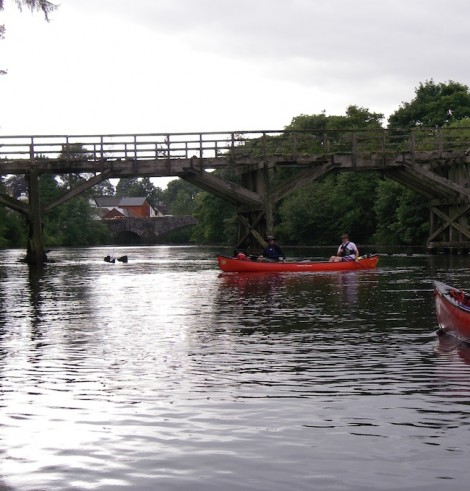
Our true start point, the bridge over the River Oich
We made our way up the Western side of the Loch past Port Clair and on to Invermoriston where the River Moriston flows into the loch. Unfortunately any wind that was present was blowing in the wrong direction, so any chance of a helping hand or the opportunity for a sail was out of the question. The wind on the loch can pose quite a problem for the paddler, as there is potentially a long fetch (distance the wind can travel over the water) and the swell or waves created can easily swamp a canoe, so care should be taken.
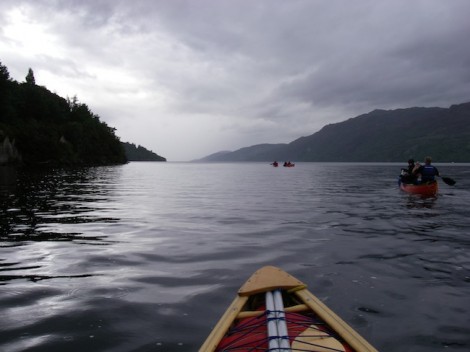
23 miles of water between us and the end!
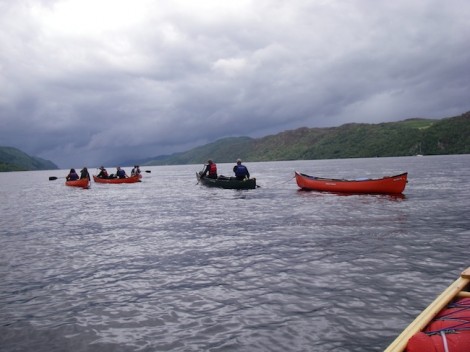
The group heading North
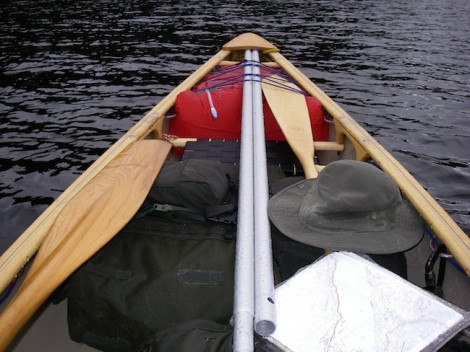
My well laden boat
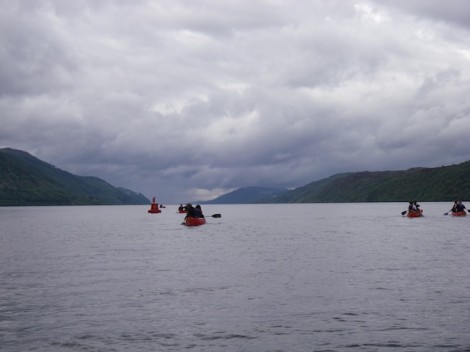
Passing Port Clair
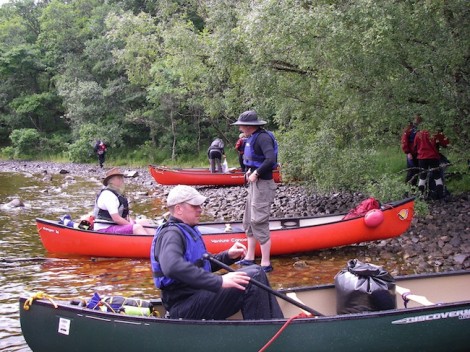
One of the many stops
Port Clair and Invermoriston were now some distance behind us and we didn’t appear to making as much ground as I had hoped. To make things worse as we headed for Alltsigh we could see a storm in the distance which was definitely heading our way.

The darkening clouds offering us warning of what was to come!
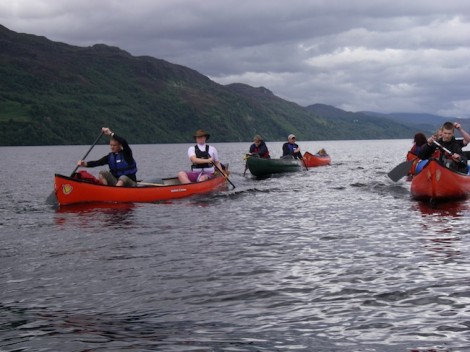
Brighter weather followed
Not sure if its a good thing or not that you can see what’s coming, I mean do you really want to know that very soon your going to get very wet! Sure enough about twenty minutes later it hit us head on. Strong squally winds and torrential rain. This forced us to stop and take refuge in the trees along side. The group produced some hot food and entertained themselves whilst I decided on a plan of action. As if by magic after forty minutes or so it stopped and the sun broke through. It was now getting quite late with not much light left so we quickly packed up and set off, crossing to the Eastern side and heading for Foyers where I had planned to camp for the night. This would then mean that we were as good as half way.
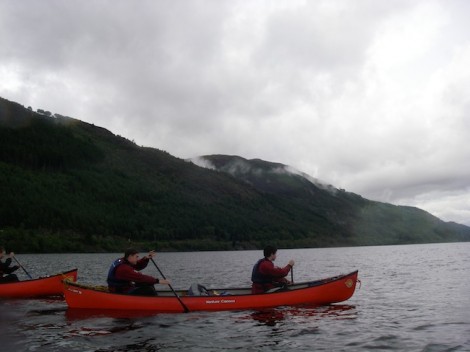
Heading for the Eastern shoreline
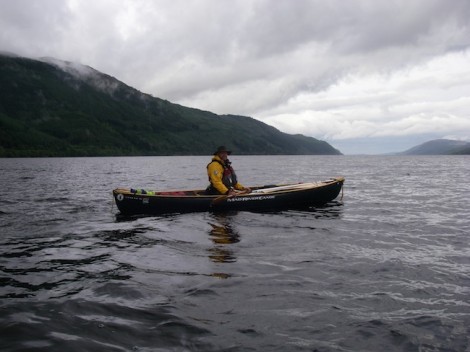
Me half way across
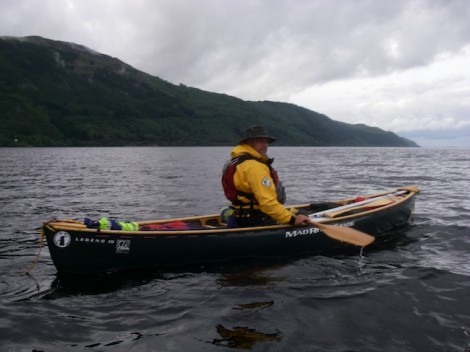
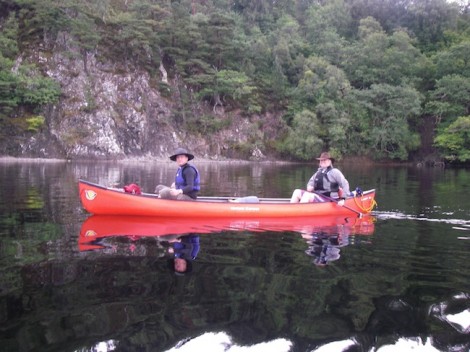
Smiling faces and better weather over on the Eastern shore
Once we had safely crossed to the other shore a short paddle brought us to Foyers. After a quick recce I found a nice little sheltered beach not far from where the River Foyers enters the Loch.
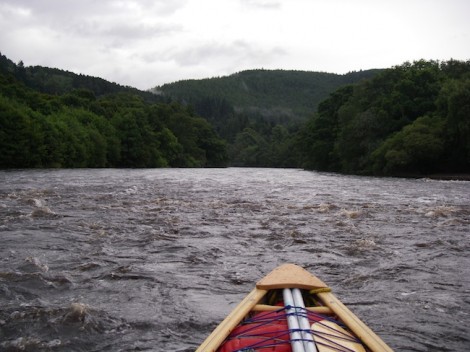
River Foyers
Not long after landing the group had set up camp and had got some food on the go. They had opted to use tents, but as usual I had gone for a boat and tarp combination. I rarely use tents if I can help it, as tarps are alot more flexible and rather more in keeping with the traditions of the open canoe. With some thought and experimentation a good shelter can be produced that will protect you well in the most challenging conditions. In this case because I chose to camp on the beach I used my split canoe pole to form a frame. Due to the stony environment of the beach tent pegs weren’t an option, so instead I tied my guy-lines onto pieces of driftwood I had found and buried them under large piles of stones. I like to use waterproof cotton tarps as opposed to nylon. My main reason being that if I choose to use an open fire for heat and cooking there is less of a chance that holes will be created by random sparks.
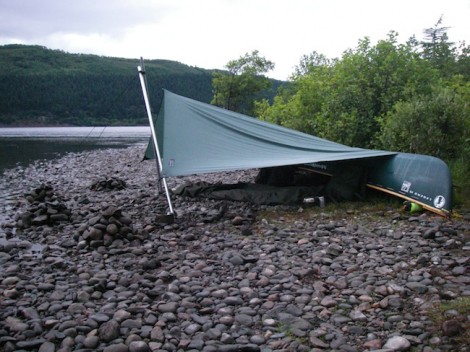
Home sweet home
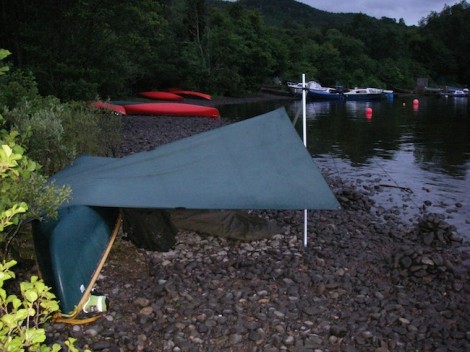
After a good meal I decided to explore the local area a little before hitting the sack. I had noticed quite a strong aroma from around the area of my tarp and it didn’t take long before I found its source. Just behind where I had pitched was some wild mint, so it made sense to have a quick brew of mint tea before bed.
With the sun setting I was happy in knowing that we had at least made it half way. I was left with thoughts of what the following day would offer, or more importantly what the weather would throw at us?
I will leave you with this parting shot.
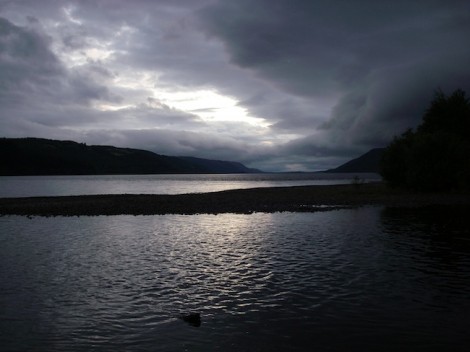
Sunset over Loch Ness from Foyers
To be continued…
See you on the water ….
Jules
www.voyageur-coaching.co.uk
This is another tale from my recent trip to Scotland.
After an overnight drive I arrived in Kinloch Rannoch at around 3 am and knowing the forecast for the day was good decided to snatch an hour or so sleep before setting off on my trip. A short time later I awoke as the sun broke through, and I was greeted with the stunning early morning view of Loch Rannoch.
Not wanting to miss the opportunity of a day of solitude and paddling on my own, I quickly unloaded my boat, kitted up and was on the water leaving the sheltered beach behind me by 6 am.
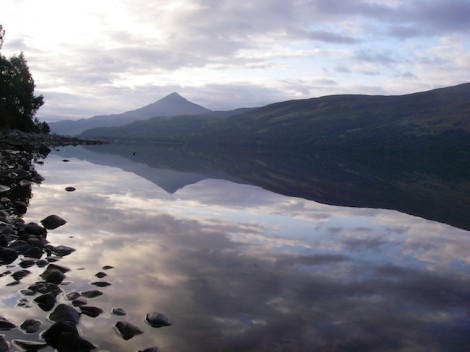
Early morning over Loch Rannoch looking back towards Kinloch Rannoch
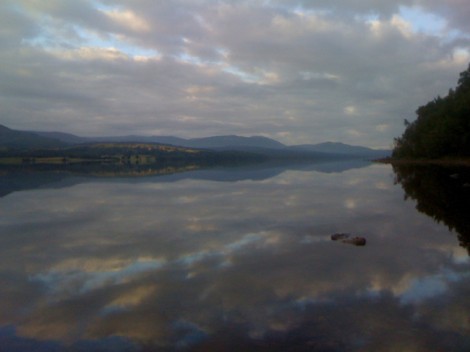
From the same place but this time looking North. Stunning!
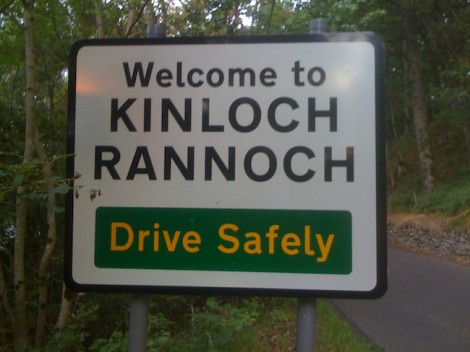
Does what it says on the tin!
The area around Rannoch Moor and Loch Rannoch has to be one of my favourites, so much so that I named my dog Rannoch!
Loch Rannoch its self lies to the East of Rannoch Moor and North of Sterling in the North of Scotland. It is easily accessed from Pitlochry on the A9, which is one of the major road routes through Scotland. It is part of a classic and very committing cross Scotland trip, which starts at Kin Loch Leven south of Fort William and ends over in Perth on the East coast. The Loch it’s self is around 15 km long with lots of opportunities for stopping and wild camps. Due to the mountainous terrain, and the surrounding wooded areas it almost has that Canadian feel about it.
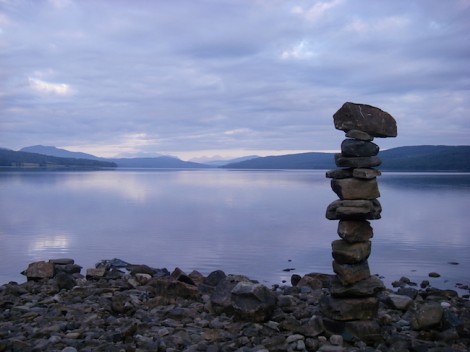
The view from my start point on the beach looking North
My aim had been to complete a short section of this route, by paddling the length/around Loch Rannoch, portage into Dunalastair Water then down the River Tummel through Loch Tummel and finish up somewhere around Pitlochry.
In keeping with the ways of the Voyageurs I had opted for a “Hudsons Bay Start.” This was basically a practice run for the Voyageurs to make sure that they had the right equipment and that things worked as they should before heading off into the wilderness. It involved a short first day, setting up camp early and not too far from home incase there were any issues that needed them to return home to be dealt with.
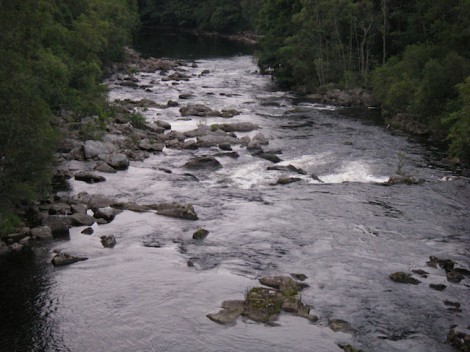
A rather low River Tummel
However as they say “All good plans fail at their first contact with the enemy!” and mine certainly did, as the water in the River Tummel was very low. I decided this probably wouldn’t make for enjoyable trip, and so opted to circumnavigate the loch, portage into Dunalastair Water and spend some time exploring it.
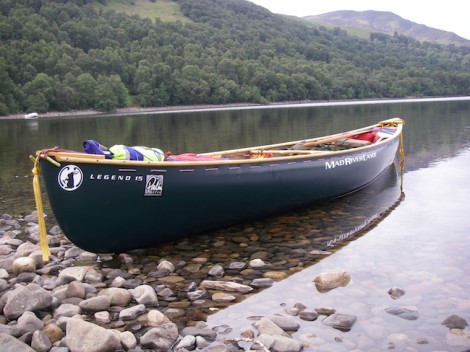
My trusty steed, loaded and ready
So shortly after 6 am with my trusted steed loaded and ready, I set off. I chose my Mad River Legend, not the best choice for an open water trip as it is more suited to moving water. However as I only had the room for one boat on this trip, and as my plans for later that week included paddling some rivers then it made sense to take it.
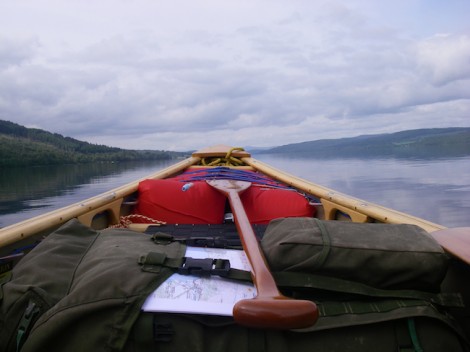
Headed North
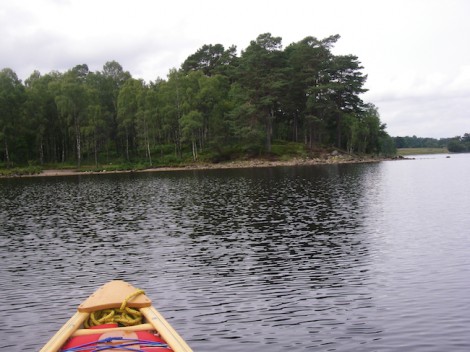
The first of my stops
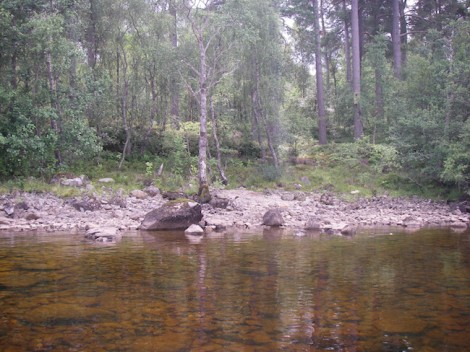
One of the many sheltered bays, ideal for a wild camp
As those who know me will tell you, I am some what of a self confessed Bushcraft geek and love foraging around for things I can use during trips. This little adventure was to be no different. In this instance during a stop it was an acompliment of Bilberries to add to my planed breakfast of porridge and some Birch bark to help light my fire and Kelly Kettle. Bilberries are basically a smaller and tastier European variety of the Blueberry, and in Scotland are known as Blaeberries. I will talk more about Kelly Kettles in a future blog with tips on using them.
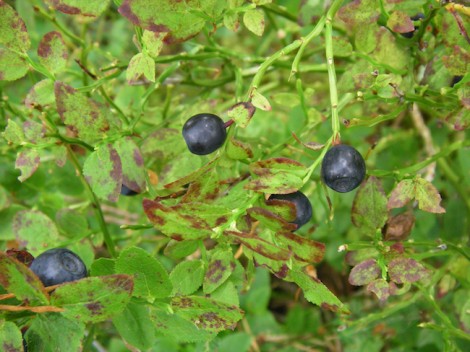
Bilberry or Blaeberry?
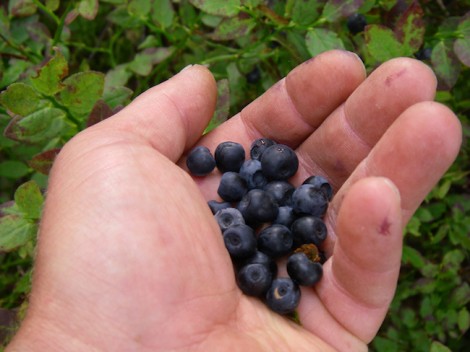
A good collection of Bilberries destined for my porridge

Breakfast with a view
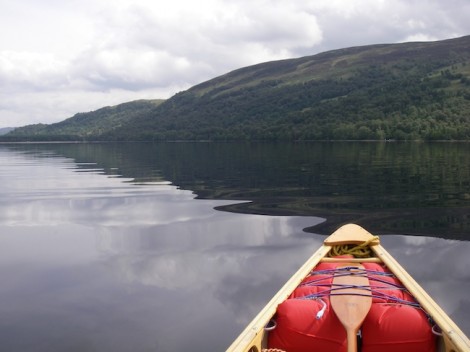
Looking across the Loch
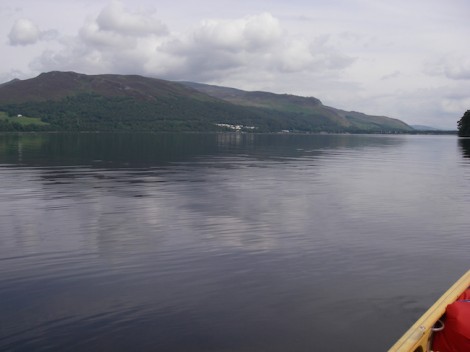
Heading back down the Loch towards Kinloch Rannoch
Fed and watered I continued on my way and by late afternoon I had completed a full circuit of the Loch. The weather was great and the scenery stunning. After another of many short stops I portaged into Dunalastair Water and found a bivy spot for the night.
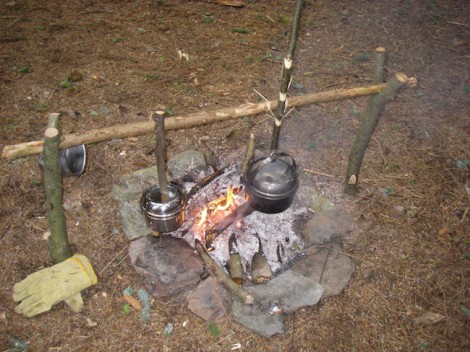
Evening meal on the go
Next morning I was again up early and explored the area before finally heading back to my original start point. I can thoroughly recommend the area and the trip. The opportunities for wild camping are plenty and there are numerous options to either extend the trip or to include it as part of longer trip.
I hope you have found this interesting and may be it will inspire some of you to have some canoe ventures of your own.
See you on the water…
Jules
www.voyageur-coaching.co.uk
It was whilst I was up in the North of Scotland doing a recce for a future expedition next year, and working that I came across this little gem of a trip for open boaters. It takes in a number of Highland Lochs and rivers as it winds its way down from the high ground heading east to sea level. It starts at Loch a Chroisg, Achnasheen some 40 miles west of Inverness, and ends at Connon Bridge just outside of Dingwall, which is on the Cromaty Firth.
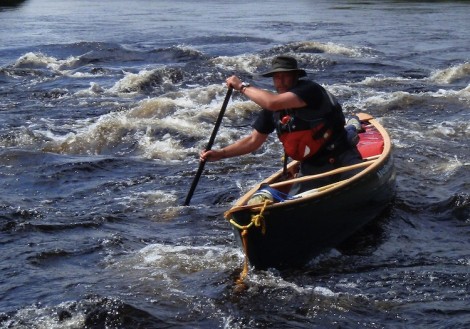
I always feel Scotland has so much to offer the open boater, with very few if any access issues and the ability to wild camp in most areas. Add to this the real feeling of remoteness that can be achieved, and it makes it the closest thing to paddling in Canada most people could experience in this country. It also gave me a great opportunity to try out my new Mad River Legend.
I was joined on this trip by a good friend and paddling partner Andy, who produces some fine wooden paddles in his spare time. In fact this winter I am hoping he will educate me in the skill to produce my own. I will keep you posted.
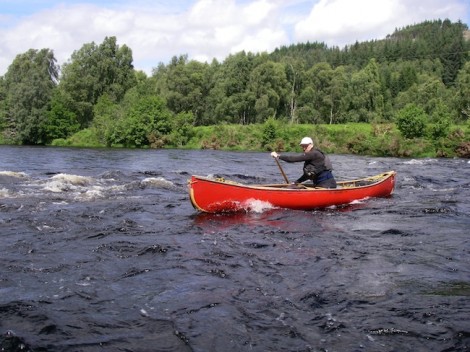
We started at a very open and wind swept Loch a Chrosig and headed east down the River Bran, which makes for an interesting paddle interspersed with need to use a pole or line every now and then. This eventually winds its way down to Loch a Chulinn followed by a short 2km portage around one of several power stations and into Loch Luichart. Again a very open Loch and exposed to westerly winds. At this point we played with the idea of putting a sail up but thought better of it as by this time the waves around us were rather large and there was a risk of swamping. A rather comical moment occurred here as we suddenly noticed a deer very close by. Strange to see only one we thought, however just like a scene from old black and white cowboy film where the Indians surround them, heads appeared one by one leading away up the hill and into the distance. You had to be there I guess! Despite being given some local intelligence we failed to see any Eagles however.
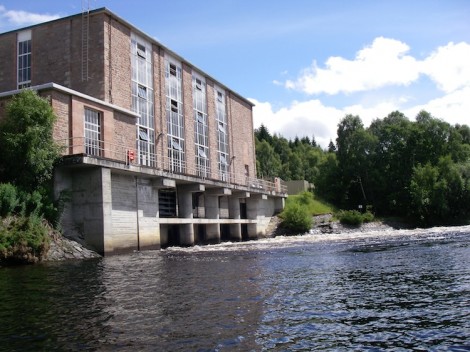
One of the many power stations on route
That night we endured a rather wet and windy bivy and at times battled with the midges. At this point I was really glad we had stopped off in Dingwall and bought some midge jackets, not hoods but jackets!
Next morning we again set off and tackled another of the portages around a power station and a short gorge section onto the River Connon.
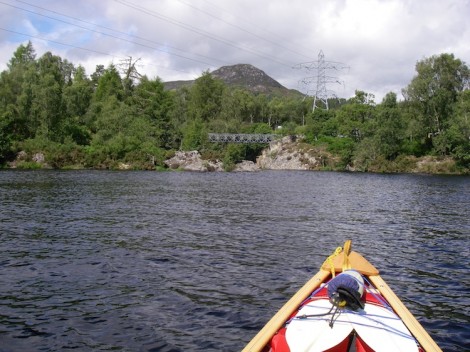
Start of the River Connon looking back towards Loch Luichart and the gorg
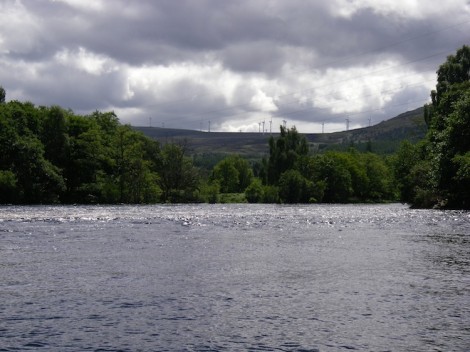
Looking down the River Connon
This is where the trip and the river really takes on a character all of its known. Several fairly flat sections are followed by numerous grade 2 rapids, with some great surf waves and fun places to play.
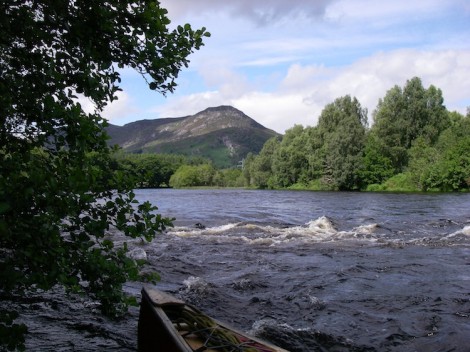
The start of some of the rapids
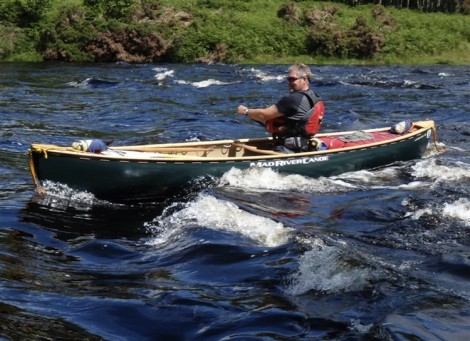
Enjoying the day

A moment for some reflection, and a quick "Where are we?"
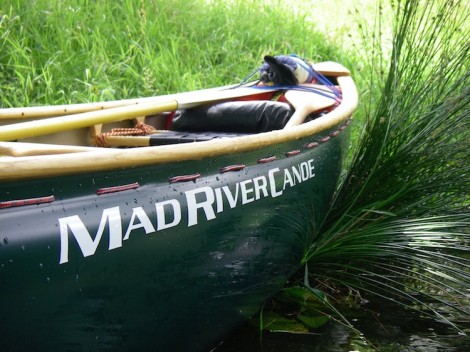
Even boats need a rest some times!
One final rapid on this section leads into Loch Achonachie. Again only grade 2 but still nice to have and mess about on. It was after having been here for a while and just before we set off across the Loch that we noticed the rapid was dropping off! Un be-known to us at this time was that the Connon’s rapids are dependent on a release from the power stations. If timed right as one release ends into the Loch another starts flowing out from the other end, providing more interesting paddling

Final rapid entering Loch Achonachie
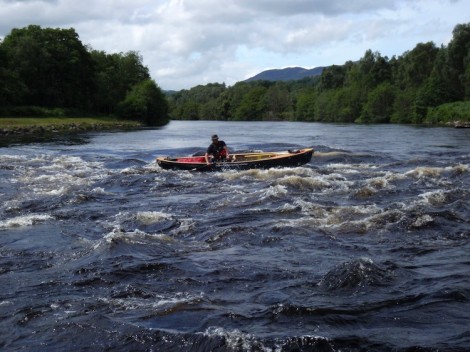
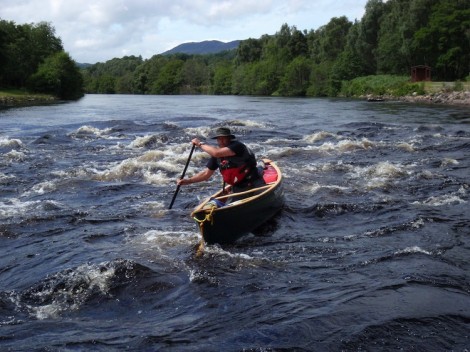
The river continues its journey east in much the same way, flat but moving, interspersed with sections of grade 2 rapids before entering a tidal section just before the get out.


Nu-tache-wan-asee, Man-that-plays-in-the-Rapids !
A really enjoyable paddle in an area with some stunning scenery. The wildlife is in abundance and on this section in particular there is the opportunity to see Otters. If you are in that area and get the chance go and paddle it, you wont regret it. Hope you enjoy reading this as much as I did paddling it.
See you on the water…
Jules
My tale begins a few weeks ago when I came up with the crazy idea of doing the Tryweryn the wrong way! Yes that’s right starting in Bala and journeying up the river. Its a canoe thing. I was inspired by the tails of someone having done this from the road bridge part way down, up to by Chapel Falls. Just so you know Polling is one of the traditional canoe skills dating back to the times of the fur trade and the Voyageurs, where this skill would have been used for up stream travel in order to access other areas and rivers etc. It is said to be the fastest way of progressing upstream under human power, and in shallow water is often the only way to progress either up or downstream.
The technique requires the paddler to stand up in their canoe (good balance needed) and to then propel the canoe forward with the use of a pole, some 12-13 feet long. Sounds simple, but believe or not it takes some practice. There are Poling competitions/races held abroad and there is actually a world champion. Some of these competitions also require that some drops are climbed, again using the pole.
So my idea was hatched, my aim was to ascend as far up as I could before the water went off, but without portaging as such and to try and pole as much as possible with only the odd “Glide & Slide” over rocks or the quick use of a line. I asked a good friend of mine to accompany me for morale, as a photographer and as a witness to my efforts. Unlucky for him he didn’t realise my intentions and even worse, I still ask him to accompany me now on more challenges I have planned. So thank you for that Iain.
So the day arrived and we met in Bala behind the Fire Station, where I broke the news to him of my intention. Shock is the word that springs to mind! Not only that but he also reminded me that the river was on a 10 cumec release that day. As we prepared for our venture a group arrived in the car park for a drop off and asked us of our planned day. Again the look of shock on their faces was a picture, and I don’t really think they believed us or thought it could be done. They did however wish us luck and said they would see how far we managed to get as they came down. Added very tongue in cheek were the words “Expect to see you just above the falls then in a few hours then!”
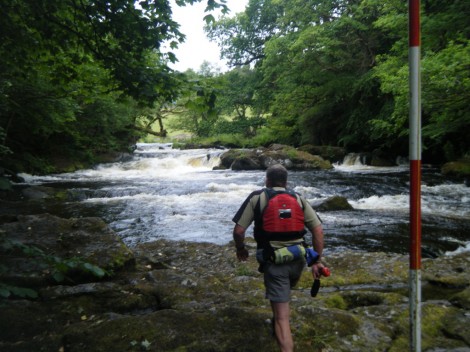
Quick recce before tackling Bala Mill Falls. I opted for a Glide & Slide up the right hand side
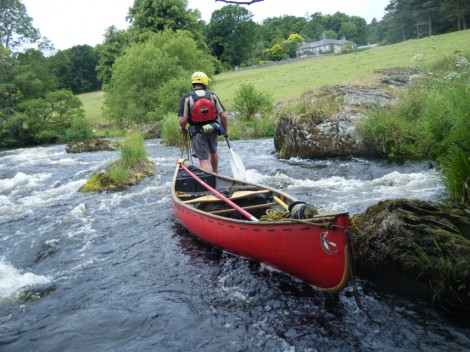
Onward and upward after the falls
I would be lying to say it wasn’t challenging at times. Some sections took several attempts to get the line right, and I did take one swim when a branch jumped out on me from behind, lost my boat and resulted Iain having to rescue it some distance down stream and me being on the opposite bank. My pole took somewhat of a hammering and now has more bends and kinks in it than a mountain track. On one occasion I thought I would be clever and try and bend it back by placing it between two rocks and bend it the opposite way. Not too sure that was a good move.
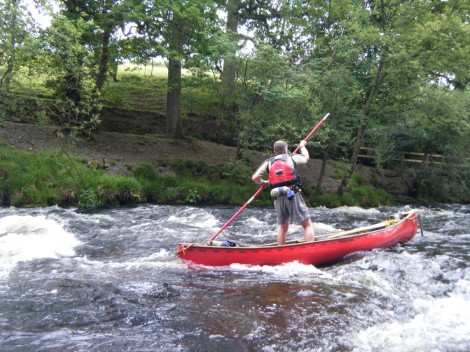
Poling up one of the interesting sections
The day moved on and Ian admitted it was a bit too much for him, and so adopted more of a support role/spectator preferring to laugh at my efforts and at times frustration. I only needed to use lines once and slid over the rocks on a couple of occasions, but most was done with the aid of a pole. A few hours into it the group we had seen at the car park came down he river astonished at how far we had made it and congratulated us along with a few sarcastic comments.
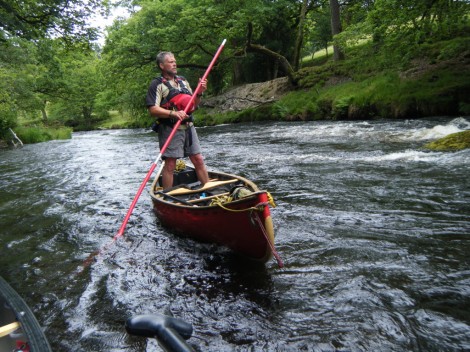
Time for a quick breather and look for the next line
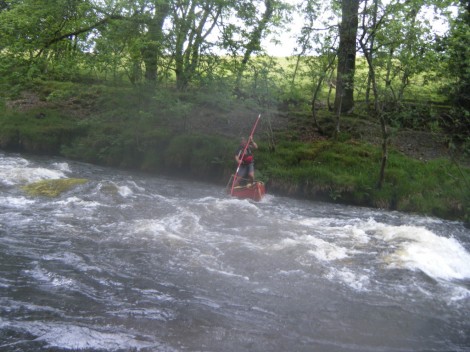
Could this be the right line?
Not long after a group of kayakers came floating by offering such words of wisdom as “Aren’t you going the wrong way” or “Its much easier going down“. Thanks for that. By now the time had moved on and it was close to the water shut off time so whilst Iain rested I pushed on further up to the road bridge, more often know as Half Way Bridge passing another kayaker whom I recognized and also looked in disbelief and offered words of encouragement like “Why would you want to do that.” Just short of the bridge by only 50 or so meters I stopped and turned around conscious of the time and made my way back to Ian and his resting spot. It had taken four and half hours to get this far, but it only took 40 min to get back down to the carpark.
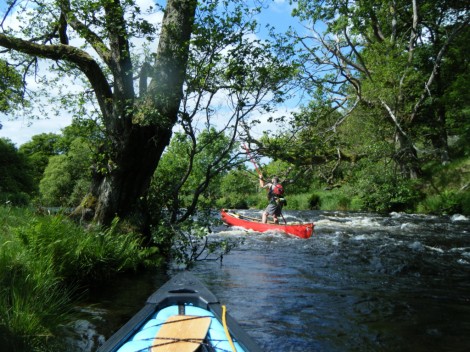
Late on in the day getting near the bridge and Iain's rest spot
Tired but happy we loaded boats and chatted about the day. I feel confident next time I could complete the trip all the way from the Fire Station up to Chapel Falls, but only time will tell and I will save that for another day.
You can read Iain’s full account of the day by visiting the link here.
Thanks Iain for being my wing man and writing the article. I look forward to our next adventure together. By the way have I told you of my next plan….?
See you on the water..













































































































































































